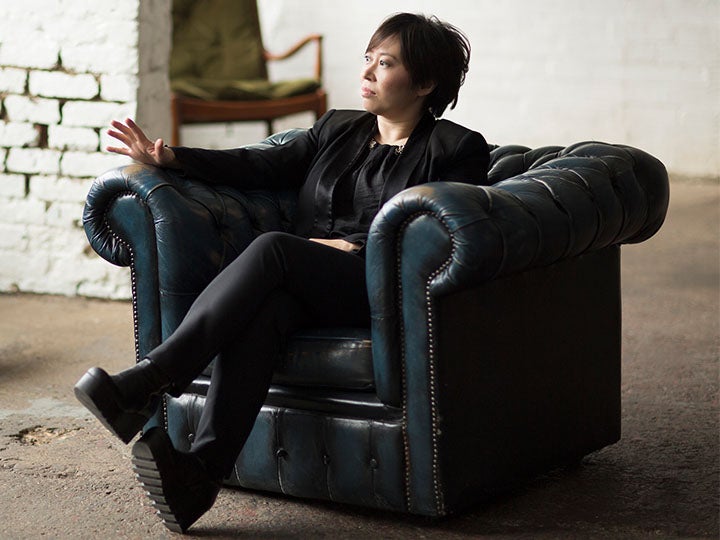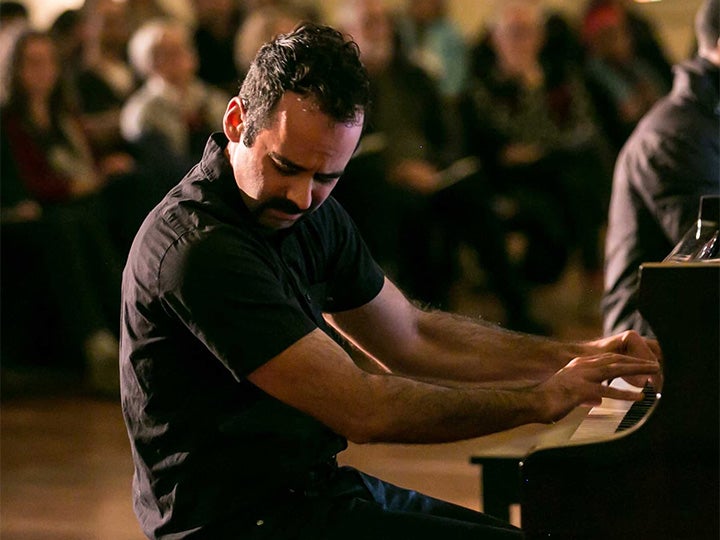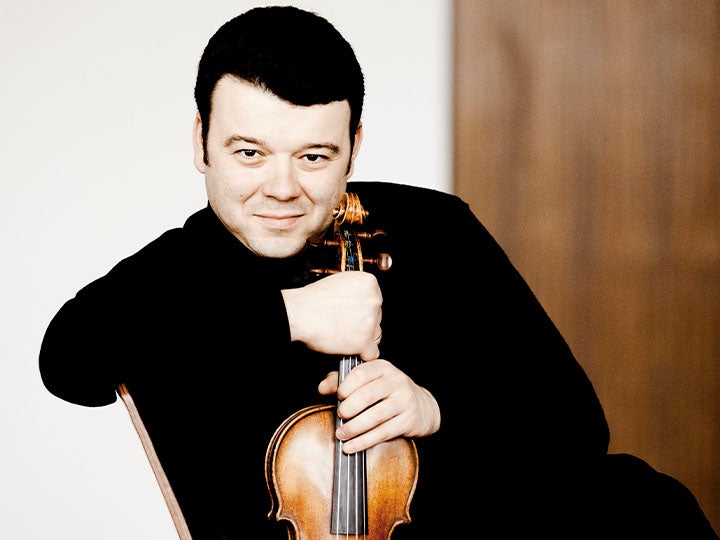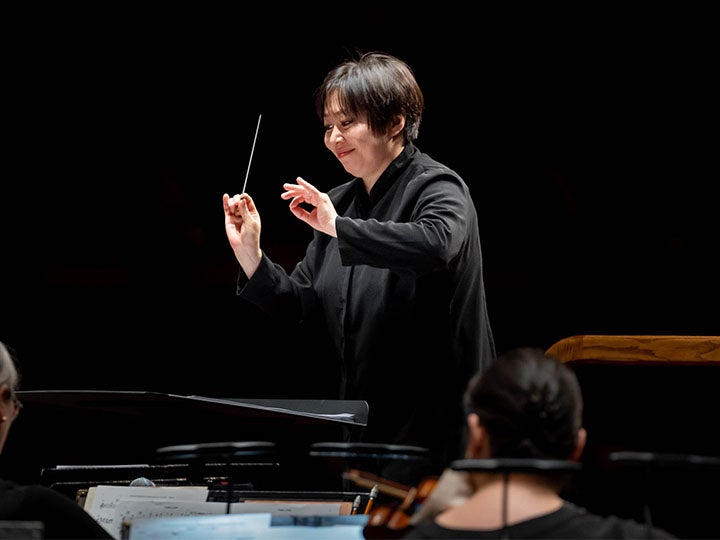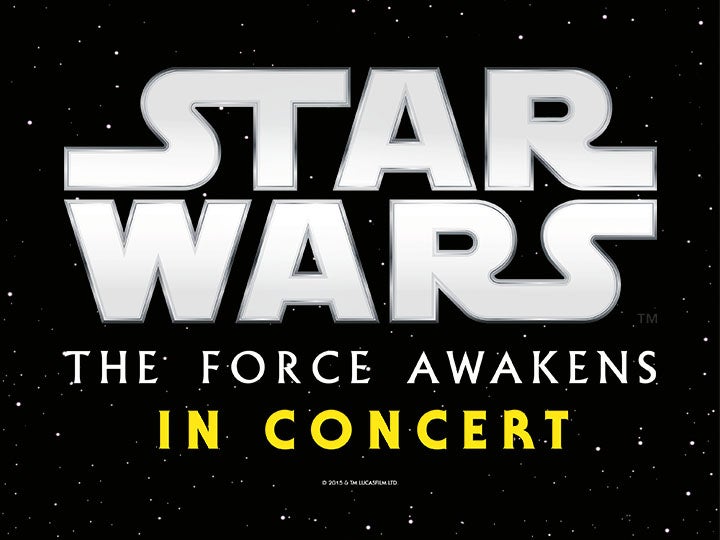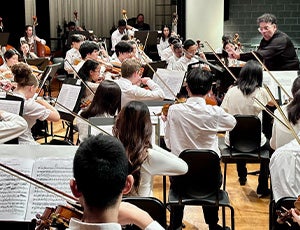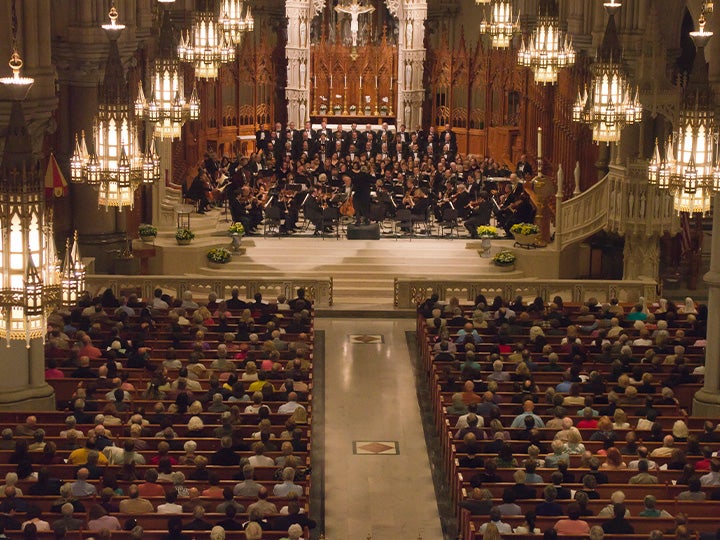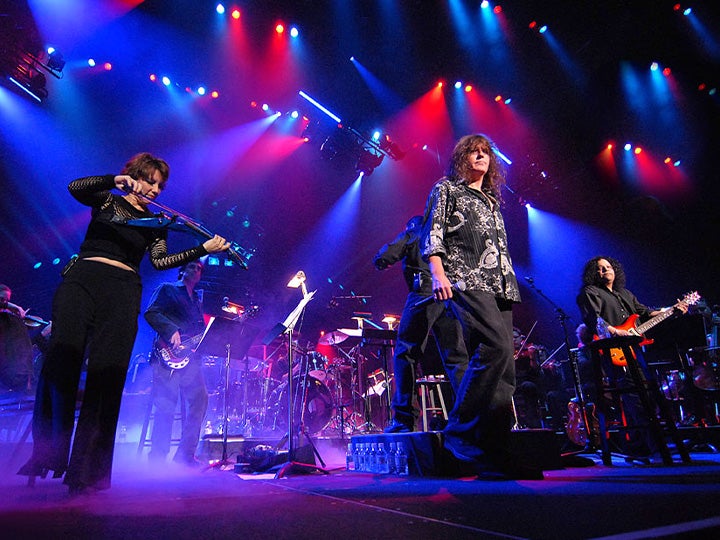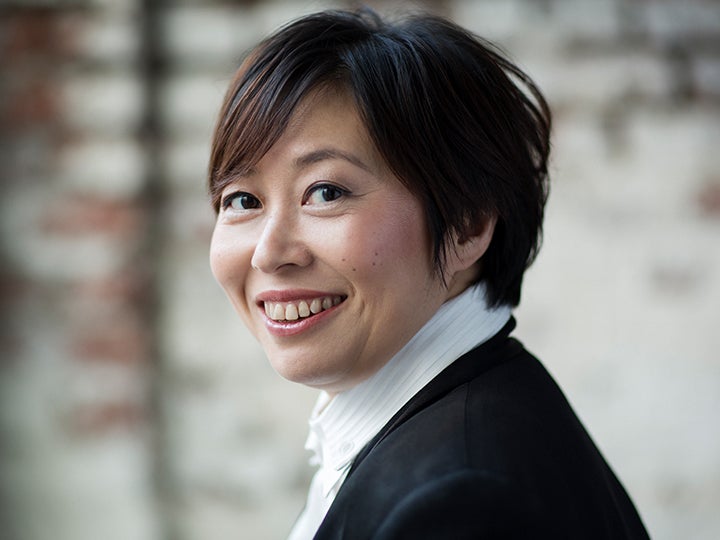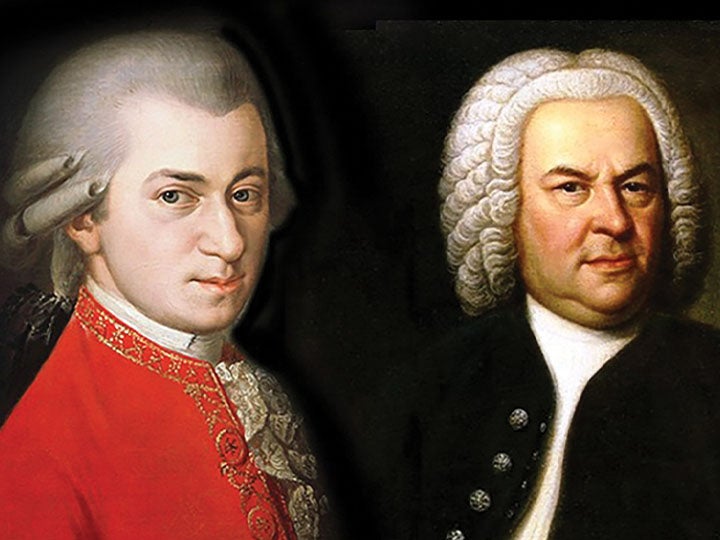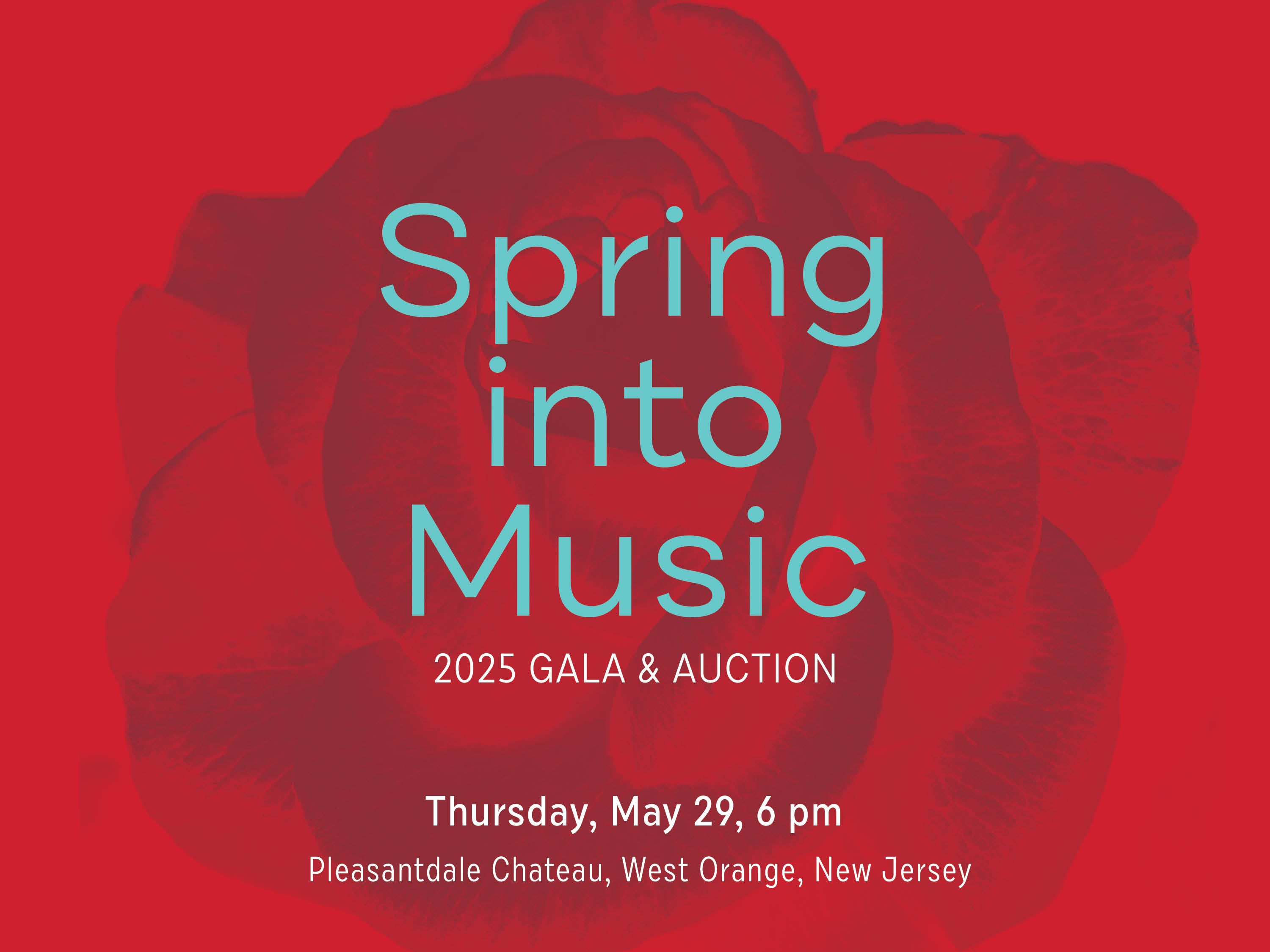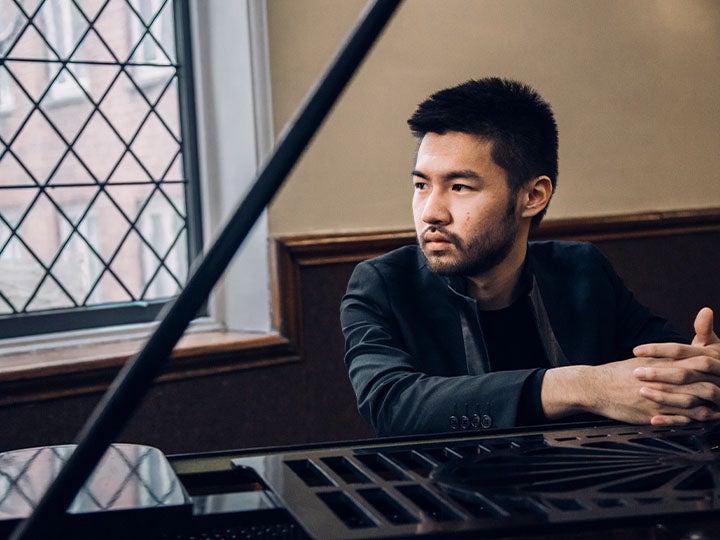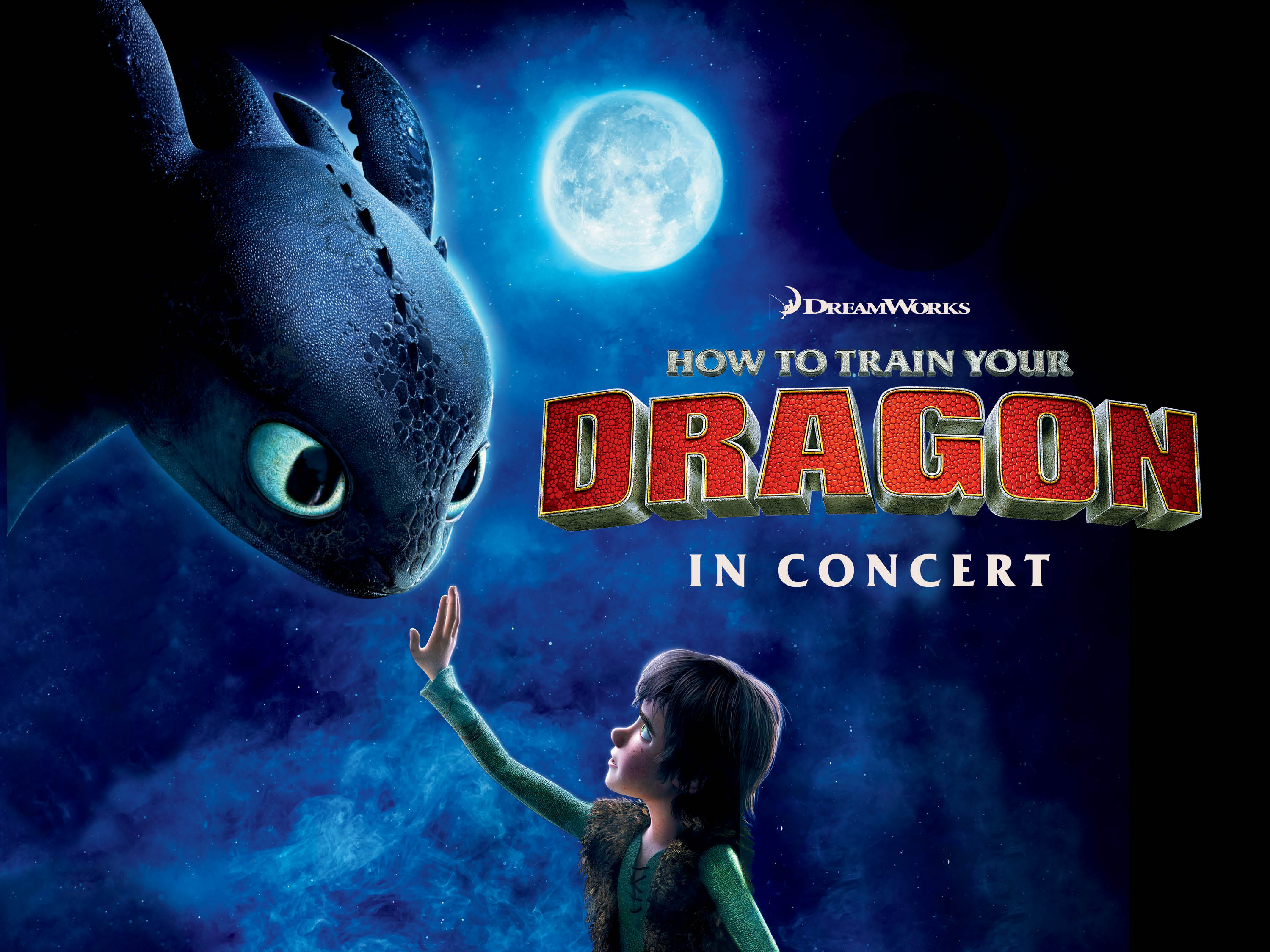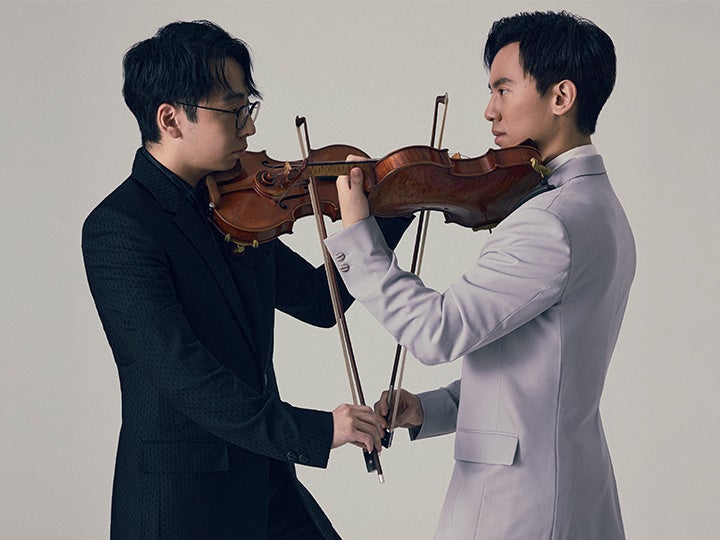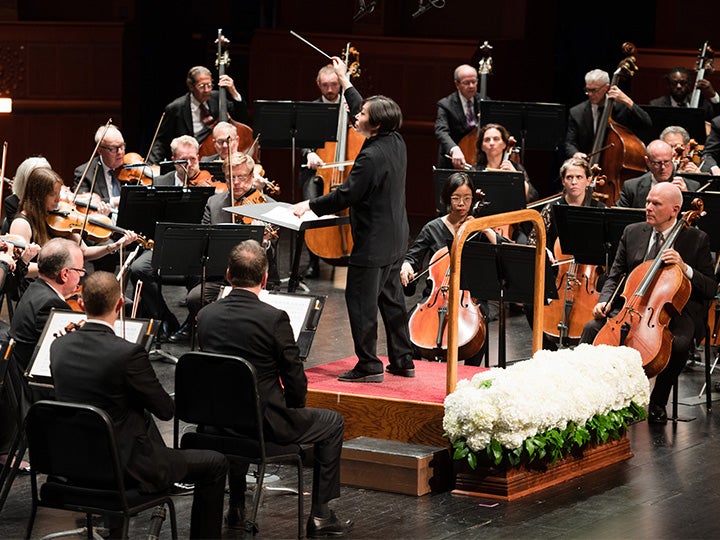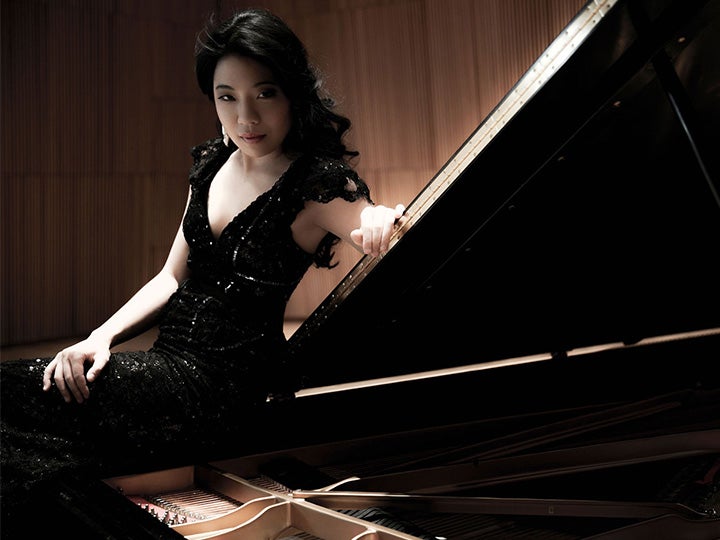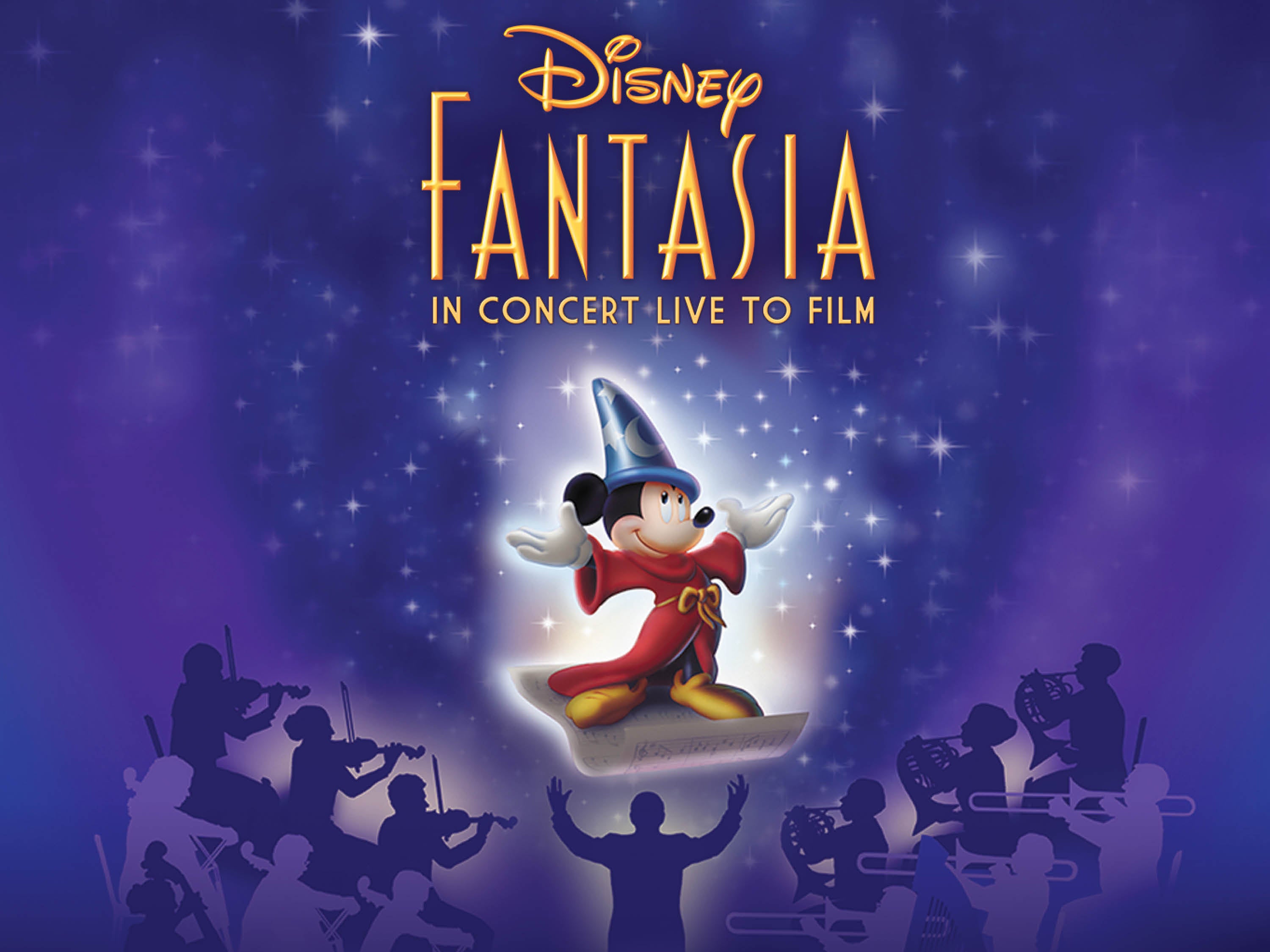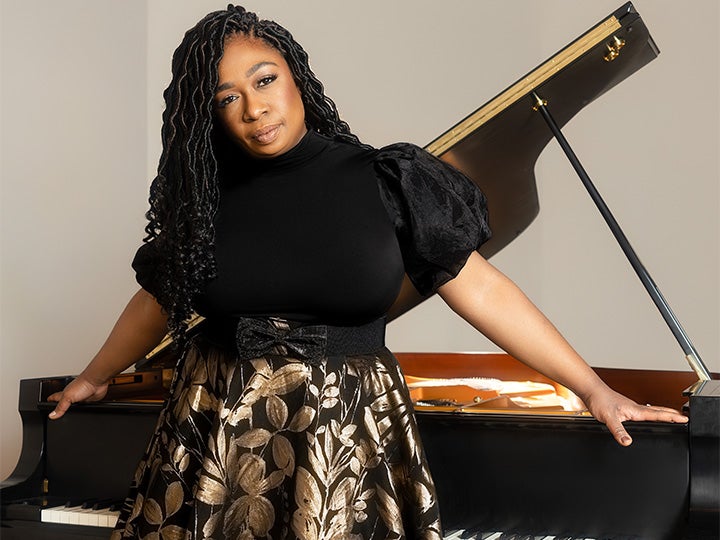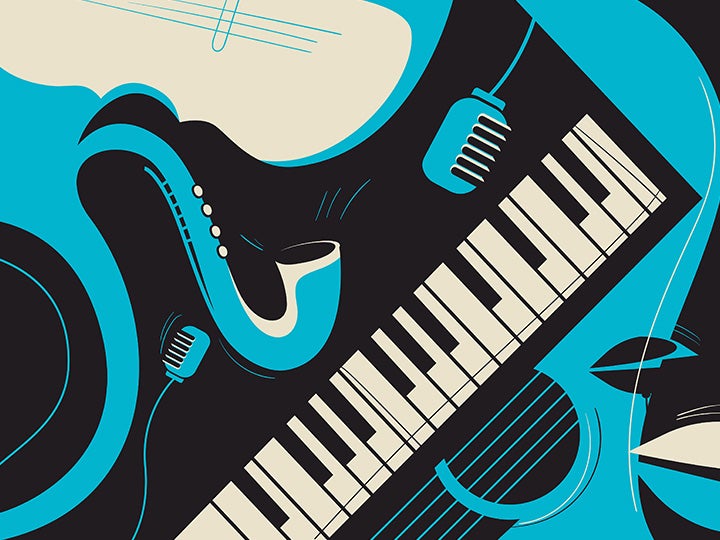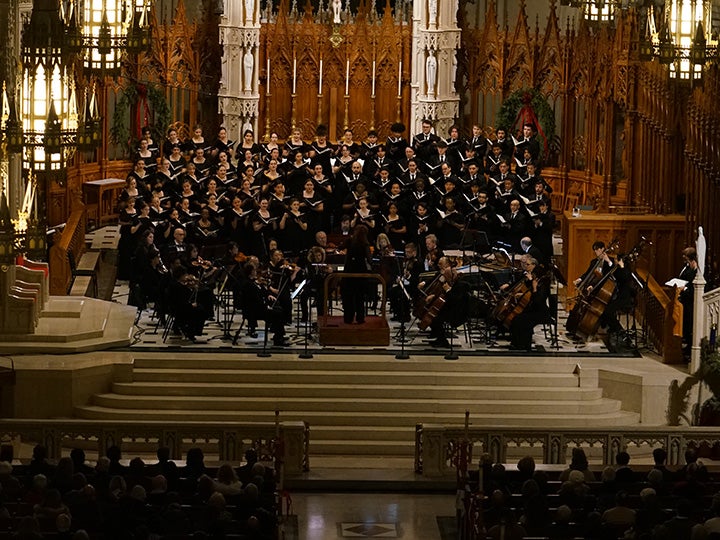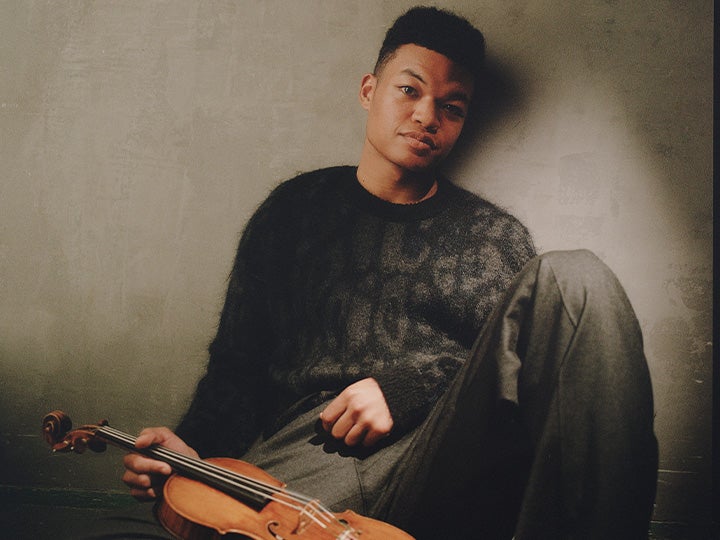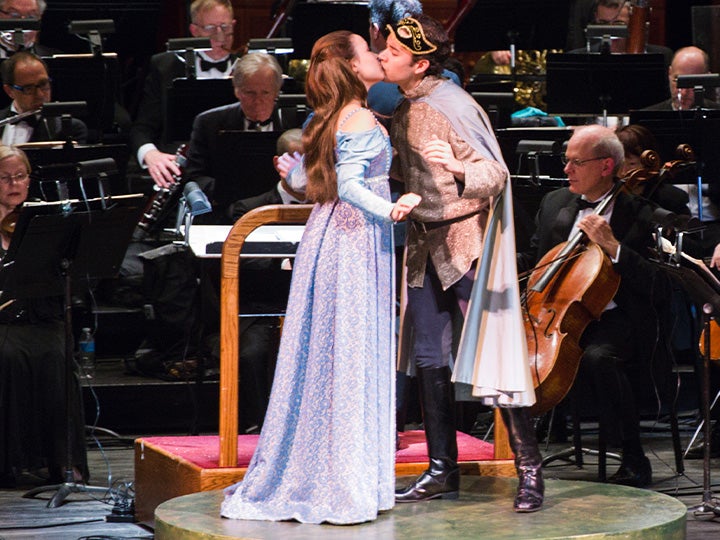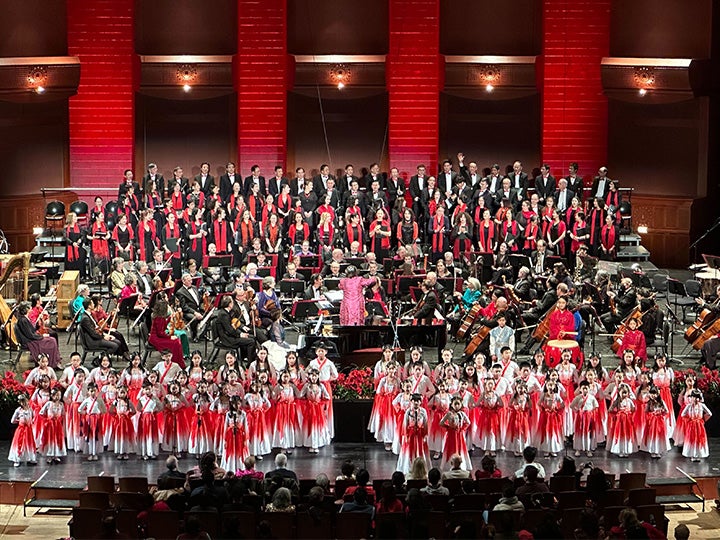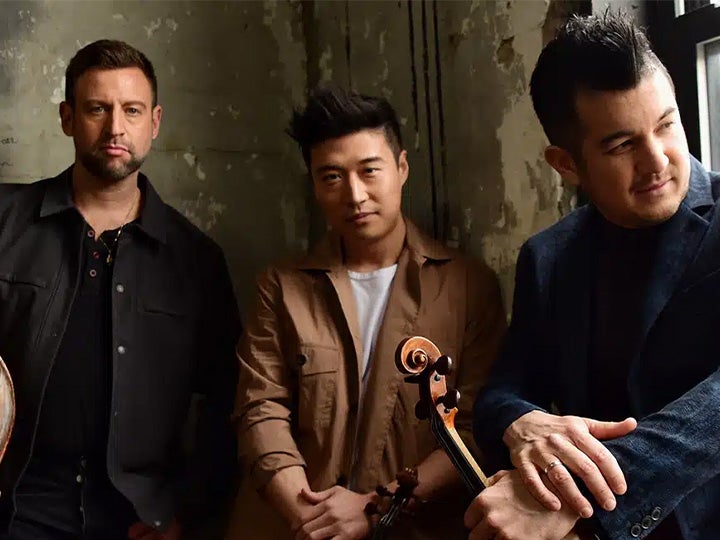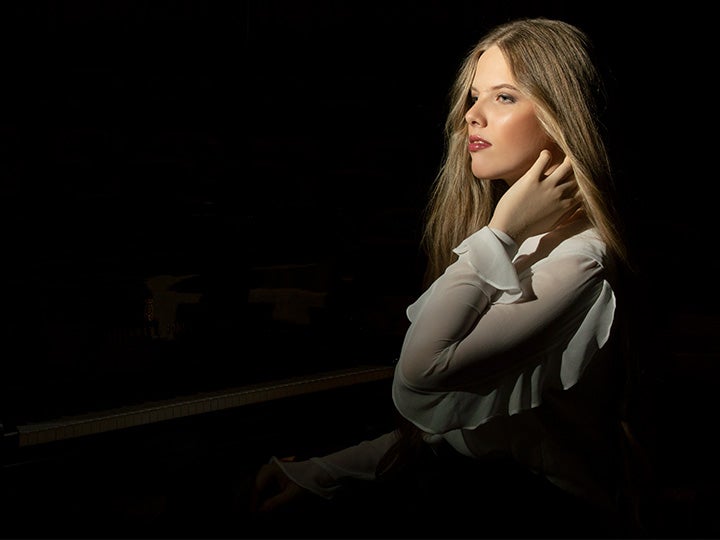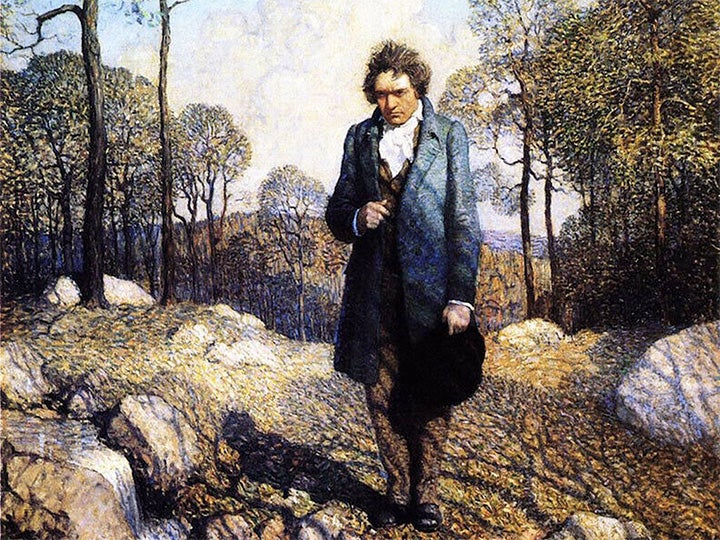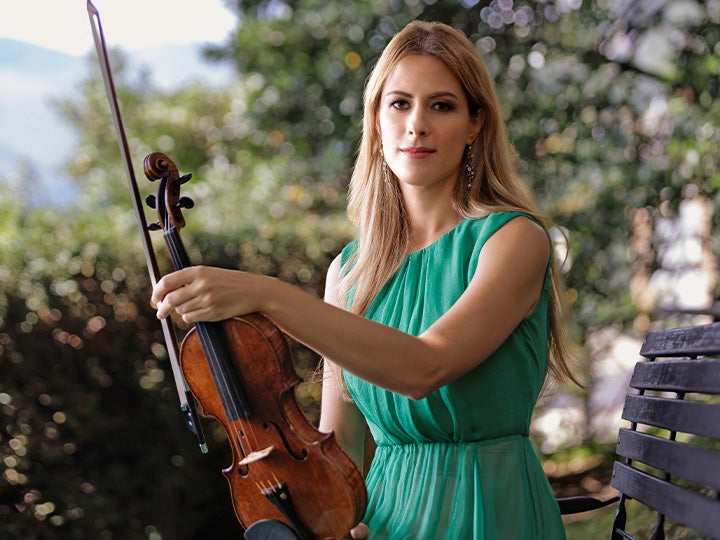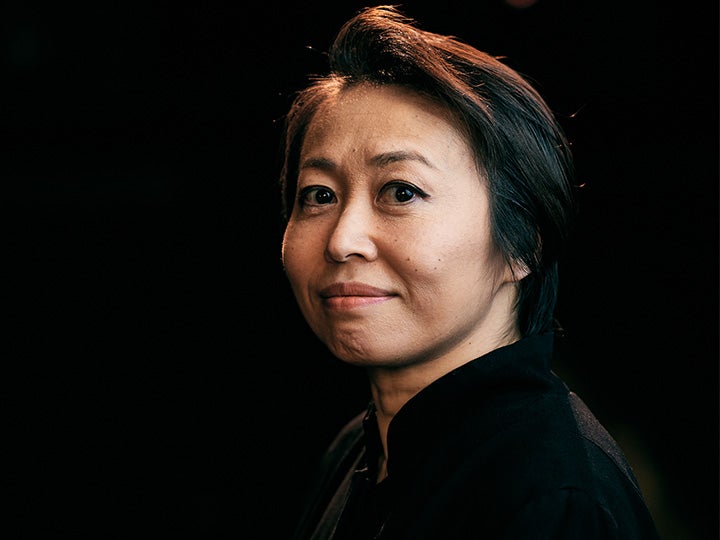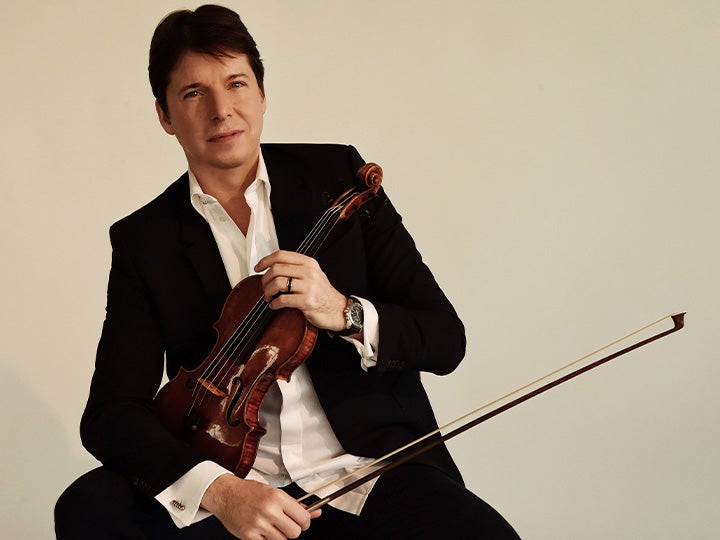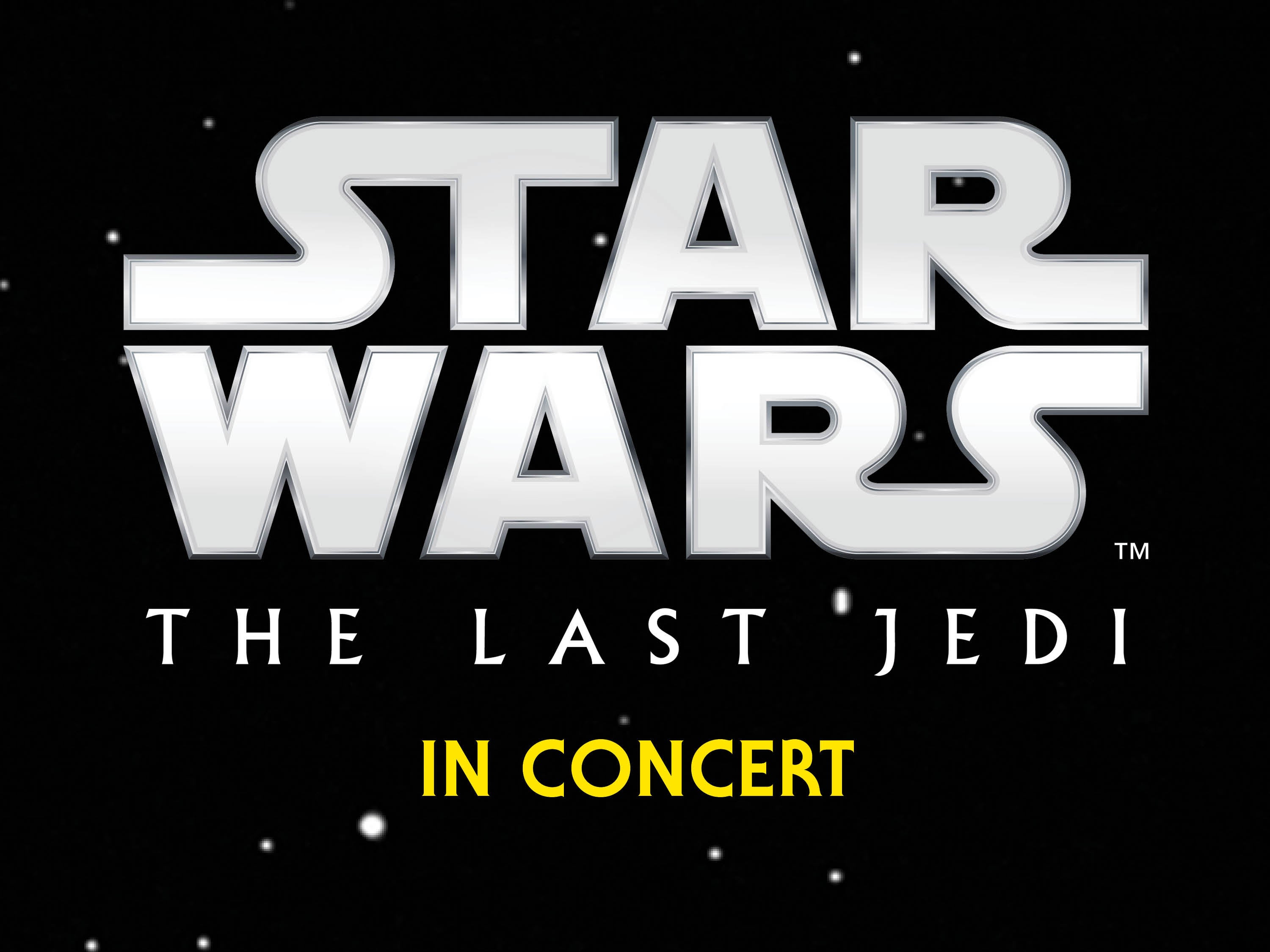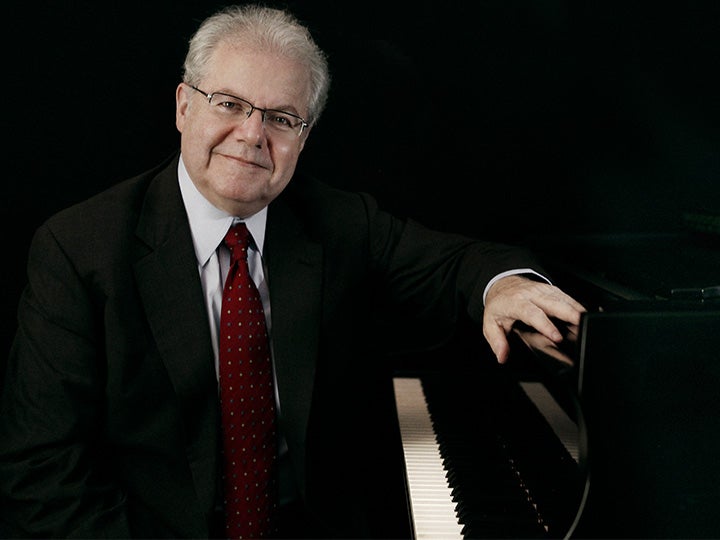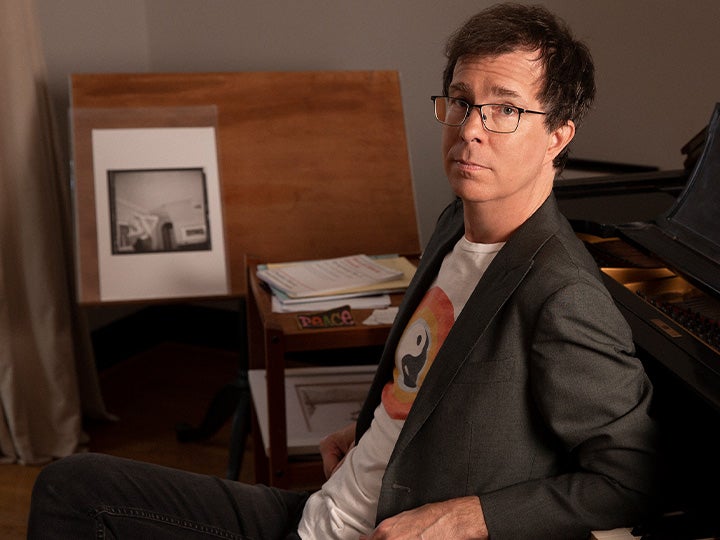The Firebird with Xian Zhang
Featuring Nimbus Dance and new dance choreography! | New Jersey Symphony Classical
Xian Zhang conductor
Jonathan Spitz cello
Nimbus Dance | Samuel Pott, artistic director & choreographer
New Jersey Symphony
- Johann Sebastian Bach Prelude from Cello Suite No. 2
Behold the majesty and wonder of solo Bach, as Principal Cello Jonathan Spitz spins this mesmerizing theme from thin air.
- Caroline Shaw Valencia
The valencia orange, described as “a thing of nature, yet so complex and extraordinary” inspired this expertly-crafted spring quartet.
- Qasim Naqvi God Docks at Death Harbor (Piano Quintet Version)
Naqvi calls this piece “a vision of our planet years from now … the quiet and peacefulness of a world restoring itself.” Nimbus Dance joins with brand new choreography, titled “Dark Water.”
- Igor Stravinsky Divertimento from The Fairy’s Kiss
Stravinsky loved the Romantics like Tchaikovsky, and created this charming and lilting Divertimento after him.
- Igor Stravinsky Suite from The Firebird
Stravinsky's The Firebird has one of the most exciting finales in all classical music, brought to life here with Nimbus Dance at center stage for the Newark concerts. In a dramatic and inventive departure from traditional renditions, Samuel Pott and Nimbus Dance reimagine The Firebird blending myth and modernity. In this tale, an Icarus-like figure, and a girl from a family in turmoil, seek freedom and liberation through flight.
Performed in Newark and Red Bank
The Firebird with Xian Zhang
Featuring Nimbus Dance and new dance choreography! | New Jersey Symphony Classical
Xian Zhang conductor
Jonathan Spitz cello
Nimbus Dance | Samuel Pott, artistic director & choreographer
New Jersey Symphony
- Johann Sebastian Bach Prelude from Cello Suite No. 2
Behold the majesty and wonder of solo Bach, as Principal Cello Jonathan Spitz spins this mesmerizing theme from thin air.
- Caroline Shaw Valencia
The valencia orange, described as “a thing of nature, yet so complex and extraordinary” inspired this expertly-crafted spring quartet.
- Qasim Naqvi God Docks at Death Harbor (Piano Quintet Version)
Naqvi calls this piece “a vision of our planet years from now … the quiet and peacefulness of a world restoring itself.” Nimbus Dance joins with brand new choreography, titled “Dark Water.”
- Igor Stravinsky Divertimento from The Fairy’s Kiss
Stravinsky loved the Romantics like Tchaikovsky, and created this charming and lilting Divertimento after him.
- Igor Stravinsky Suite from The Firebird
Stravinsky's The Firebird has one of the most exciting finales in all classical music, brought to life here with Nimbus Dance at center stage for the Newark concerts. In a dramatic and inventive departure from traditional renditions, Samuel Pott and Nimbus Dance reimagine The Firebird blending myth and modernity. In this tale, an Icarus-like figure, and a girl from a family in turmoil, seek freedom and liberation through flight.
Performed in Newark and Red Bank
The Firebird with Xian Zhang
Featuring Nimbus Dance and new dance choreography! | New Jersey Symphony Classical
Xian Zhang conductor
Jonathan Spitz cello
Nimbus Dance | Samuel Pott, artistic director & choreographer
New Jersey Symphony
- Johann Sebastian Bach Prelude from Cello Suite No. 2
Behold the majesty and wonder of solo Bach, as Principal Cello Jonathan Spitz spins this mesmerizing theme from thin air.
- Caroline Shaw Valencia
The valencia orange, described as “a thing of nature, yet so complex and extraordinary” inspired this expertly-crafted spring quartet.
- Qasim Naqvi God Docks at Death Harbor (Piano Quintet Version)
Naqvi calls this piece “a vision of our planet years from now … the quiet and peacefulness of a world restoring itself.” Nimbus Dance joins with brand new choreography, titled “Dark Water.”
- Igor Stravinsky Divertimento from The Fairy’s Kiss
Stravinsky loved the Romantics like Tchaikovsky, and created this charming and lilting Divertimento after him.
- Igor Stravinsky Suite from The Firebird
Stravinsky's The Firebird has one of the most exciting finales in all classical music, brought to life here with Nimbus Dance at center stage for the Newark concerts. In a dramatic and inventive departure from traditional renditions, Samuel Pott and Nimbus Dance reimagine The Firebird blending myth and modernity. In this tale, an Icarus-like figure, and a girl from a family in turmoil, seek freedom and liberation through flight.
Performed in Newark and Red Bank
Rachmaninoff Symphony No. 2
New Jersey Symphony Classical
Xian Zhang conductor
Gregory D. McDaniel conductor
Adam Tendler piano
New Jersey Symphony
- Claude Debussy Clair de Lune
Debussy’s original piano solo, Clair de Lune, probably exists in more versions than the Beatles’ “Yesterday” and for good reason, as none before or since have captured in music the true magic of moonlight.
- Nico Muhly Sounding for Piano and Orchestra (New Jersey Symphony Co-Commission)
New York-based pianist Adam Tendler, “currently the hottest pianist on the American contemporary classical scene” (Minneapolis Star Tribune), makes his New Jersey Symphony debut in this hymn tune-filled concerto by broadly popular contemporary composer Nico Muhly.
- Sergei Rachmaninoff Symphony No. 2
Melodies too numerous and beautiful to track—so don’t try. Just let this sweeping Romantic symphony, the inspiration for the song “Never Gonna Fall in Love Again,” work its magic.
Performed in Newark, Princeton and Morristown
Rachmaninoff Symphony No. 2
New Jersey Symphony Classical
Xian Zhang conductor
Gregory D. McDaniel conductor
Adam Tendler piano
New Jersey Symphony
- Claude Debussy Clair de Lune
Debussy’s original piano solo, Clair de Lune, probably exists in more versions than the Beatles’ “Yesterday” and for good reason, as none before or since have captured in music the true magic of moonlight.
- Nico Muhly Sounding for Piano and Orchestra (New Jersey Symphony Co-Commission)
New York-based pianist Adam Tendler, “currently the hottest pianist on the American contemporary classical scene” (Minneapolis Star Tribune), makes his New Jersey Symphony debut in this hymn tune-filled concerto by broadly popular contemporary composer Nico Muhly.
- Sergei Rachmaninoff Symphony No. 2
Melodies too numerous and beautiful to track—so don’t try. Just let this sweeping Romantic symphony, the inspiration for the song “Never Gonna Fall in Love Again,” work its magic.
Performed in Newark, Princeton and Morristown
Rachmaninoff Symphony No. 2
New Jersey Symphony Classical
Xian Zhang conductor
Gregory D. McDaniel conductor
Adam Tendler piano
New Jersey Symphony
- Claude Debussy Clair de Lune
Debussy’s original piano solo, Clair de Lune, probably exists in more versions than the Beatles’ “Yesterday” and for good reason, as none before or since have captured in music the true magic of moonlight.
- Nico Muhly Sounding for Piano and Orchestra (New Jersey Symphony Co-Commission)
New York-based pianist Adam Tendler, “currently the hottest pianist on the American contemporary classical scene” (Minneapolis Star Tribune), makes his New Jersey Symphony debut in this hymn tune-filled concerto by broadly popular contemporary composer Nico Muhly.
- Sergei Rachmaninoff Symphony No. 2
Melodies too numerous and beautiful to track—so don’t try. Just let this sweeping Romantic symphony, the inspiration for the song “Never Gonna Fall in Love Again,” work its magic.
Performed in Newark, Princeton and Morristown
Rachmaninoff Symphony No. 2
New Jersey Symphony Classical
Xian Zhang conductor
Gregory D. McDaniel conductor
Adam Tendler piano
New Jersey Symphony
- Claude Debussy Clair de Lune
Debussy’s original piano solo, Clair de Lune, probably exists in more versions than the Beatles’ “Yesterday” and for good reason, as none before or since have captured in music the true magic of moonlight.
- Nico Muhly Sounding for Piano and Orchestra (New Jersey Symphony Co-Commission)
New York-based pianist Adam Tendler, “currently the hottest pianist on the American contemporary classical scene” (Minneapolis Star Tribune), makes his New Jersey Symphony debut in this hymn tune-filled concerto by broadly popular contemporary composer Nico Muhly.
- Sergei Rachmaninoff Symphony No. 2
Melodies too numerous and beautiful to track—so don’t try. Just let this sweeping Romantic symphony, the inspiration for the song “Never Gonna Fall in Love Again,” work its magic.
Performed in Newark, Princeton and Morristown
Brahms Violin Concerto with Vadim Gluzman
New Jersey Symphony Classical
Lina González-Granados conductor
Vadim Gluzman violin
New Jersey Symphony
- Robert Schumann Overture, Scherzo and Finale
Bursting with a love of life in the months after his marriage to Clara, Robert Schumann created three fantastic movements–one shy of a full symphony but which stand magnificently on their own.
- Gabriela Ortiz Clara
A fascinating depiction of the 19th-century composer-pianist Clara Schumann’s inner life as imagined by one of Mexico's leading contemporary composers.
- Johannes Brahms Violin Concerto
A favorite of New Jersey Symphony audiences, Vadim Gluzman returns with his signature singing tone to play what Brahms began as simply “a few violin passages,” but turned into one of the greatest of all concertos.
Performed in New Brunswick, Red Bank and Newark
Brahms Violin Concerto with Vadim Gluzman
New Jersey Symphony Classical
Lina González-Granados conductor
Vadim Gluzman violin
New Jersey Symphony
- Robert Schumann Overture, Scherzo and Finale
Bursting with a love of life in the months after his marriage to Clara, Robert Schumann created three fantastic movements–one shy of a full symphony but which stand magnificently on their own.
- Gabriela Ortiz Clara
A fascinating depiction of the 19th-century composer-pianist Clara Schumann’s inner life as imagined by one of Mexico's leading contemporary composers.
- Johannes Brahms Violin Concerto
A favorite of New Jersey Symphony audiences, Vadim Gluzman returns with his signature singing tone to play what Brahms began as simply “a few violin passages,” but turned into one of the greatest of all concertos.
Performed in New Brunswick, Red Bank and Newark
Brahms Violin Concerto with Vadim Gluzman
New Jersey Symphony Classical
Lina González-Granados conductor
Vadim Gluzman violin
New Jersey Symphony
- Robert Schumann Overture, Scherzo and Finale
Bursting with a love of life in the months after his marriage to Clara, Robert Schumann created three fantastic movements–one shy of a full symphony but which stand magnificently on their own.
- Gabriela Ortiz Clara
A fascinating depiction of the 19th-century composer-pianist Clara Schumann’s inner life as imagined by one of Mexico's leading contemporary composers.
- Johannes Brahms Violin Concerto
A favorite of New Jersey Symphony audiences, Vadim Gluzman returns with his signature singing tone to play what Brahms began as simply “a few violin passages,” but turned into one of the greatest of all concertos.
Performed in New Brunswick, Red Bank and Newark
Beethoven’s Ninth Symphony with Xian Zhang
New Jersey Symphony Classical
Xian Zhang conductor
Gregory D. McDaniel conductor
Steven Banks saxophone
Felicia Moore soprano
Kelley O’Connor mezzo-soprano
Issachah Savage tenor
Reginald Smith Jr. baritone
Montclair State University Chorale | Heather J. Buchanan, director
New Jersey Symphony
- Pytor Ilyich Tchaikovsky Polonaise from Eugene Onegin
A lavish ball scene, the dashing hero and heroine twirling in splendor—a fun, festive dance lifted from Tchaikovsky’s opera.
- Billy Childs Diaspora
Inspired by Maya Angelou and other poets, Childs’ new concerto was written for the amazing Steven Banks, who says the music “follows the trajectory of the Black experience from Africa before slave trade to now, going forward in hope.”
- Ludwig van Beethoven Symphony No. 9, “Choral”
The sheer volcanic power of Beethoven’s music makes the Ninth’s message soar. “Brotherhood! Joy!”—our world needs these clarion calls now more than ever.
Performed in Newark and New Brunswick
Beethoven’s Ninth Symphony with Xian Zhang
New Jersey Symphony Classical
Xian Zhang conductor
Gregory D. McDaniel conductor
Steven Banks saxophone
Felicia Moore soprano
Kelley O’Connor mezzo-soprano
Issachah Savage tenor
Reginald Smith Jr. baritone
Montclair State University Chorale | Heather J. Buchanan, director
New Jersey Symphony
- Pytor Ilyich Tchaikovsky Polonaise from Eugene Onegin
A lavish ball scene, the dashing hero and heroine twirling in splendor—a fun, festive dance lifted from Tchaikovsky’s opera.
- Billy Childs Diaspora
Inspired by Maya Angelou and other poets, Childs’ new concerto was written for the amazing Steven Banks, who says the music “follows the trajectory of the Black experience from Africa before slave trade to now, going forward in hope.”
- Ludwig van Beethoven Symphony No. 9, “Choral”
The sheer volcanic power of Beethoven’s music makes the Ninth’s message soar. “Brotherhood! Joy!”—our world needs these clarion calls now more than ever.
Performed in Newark and New Brunswick
Beethoven’s Ninth Symphony with Xian Zhang
New Jersey Symphony Classical
Xian Zhang conductor
Gregory D. McDaniel conductor
Steven Banks saxophone
Felicia Moore soprano
Kelley O’Connor mezzo-soprano
Issachah Savage tenor
Reginald Smith Jr. baritone
Montclair State University Chorale | Heather J. Buchanan, director
New Jersey Symphony
- Pytor Ilyich Tchaikovsky Polonaise from Eugene Onegin
A lavish ball scene, the dashing hero and heroine twirling in splendor—a fun, festive dance lifted from Tchaikovsky’s opera.
- Billy Childs Diaspora
Inspired by Maya Angelou and other poets, Childs’ new concerto was written for the amazing Steven Banks, who says the music “follows the trajectory of the Black experience from Africa before slave trade to now, going forward in hope.”
- Ludwig van Beethoven Symphony No. 9, “Choral”
The sheer volcanic power of Beethoven’s music makes the Ninth’s message soar. “Brotherhood! Joy!”—our world needs these clarion calls now more than ever.
Performed in Newark and New Brunswick
Beethoven’s Ninth Symphony with Xian Zhang
New Jersey Symphony Classical
Xian Zhang conductor
Gregory D. McDaniel conductor
Steven Banks saxophone
Felicia Moore soprano
Kelley O’Connor mezzo-soprano
Issachah Savage tenor
Reginald Smith Jr. baritone
Montclair State University Chorale | Heather J. Buchanan, director
New Jersey Symphony
- Pytor Ilyich Tchaikovsky Polonaise from Eugene Onegin
A lavish ball scene, the dashing hero and heroine twirling in splendor—a fun, festive dance lifted from Tchaikovsky’s opera.
- Billy Childs Diaspora
Inspired by Maya Angelou and other poets, Childs’ new concerto was written for the amazing Steven Banks, who says the music “follows the trajectory of the Black experience from Africa before slave trade to now, going forward in hope.”
- Ludwig van Beethoven Symphony No. 9, “Choral”
The sheer volcanic power of Beethoven’s music makes the Ninth’s message soar. “Brotherhood! Joy!”—our world needs these clarion calls now more than ever.
Performed in Newark and New Brunswick
Star Wars: The Force Awakens in Concert
New Jersey Symphony at the Movies
Constantine Kitsopoulos conductor
New Jersey Symphony
Thirty years after the defeat of the Empire, Luke Skywalker has vanished, and a new threat has risen: The First Order, led by the mysterious Supreme Leader Snoke and his enforcer, Kylo Ren. General Leia Organa’s military force, the Resistance—and unlikely heroes brought together by fate—are the galaxy’s only hope. Experience the complete film with the New Jersey Symphony performing John Williams’ thrilling score live.
Performed in Red Bank, Morristown, Newark and New Brunswick
Star Wars: The Force Awakens in Concert
New Jersey Symphony at the Movies
Constantine Kitsopoulos conductor
New Jersey Symphony
Thirty years after the defeat of the Empire, Luke Skywalker has vanished, and a new threat has risen: The First Order, led by the mysterious Supreme Leader Snoke and his enforcer, Kylo Ren. General Leia Organa’s military force, the Resistance—and unlikely heroes brought together by fate—are the galaxy’s only hope. Experience the complete film with the New Jersey Symphony performing John Williams’ thrilling score live.
Performed in Red Bank, Morristown, Newark and New Brunswick
Star Wars: The Force Awakens in Concert
New Jersey Symphony at the Movies
Constantine Kitsopoulos conductor
New Jersey Symphony
Thirty years after the defeat of the Empire, Luke Skywalker has vanished, and a new threat has risen: The First Order, led by the mysterious Supreme Leader Snoke and his enforcer, Kylo Ren. General Leia Organa’s military force, the Resistance—and unlikely heroes brought together by fate—are the galaxy’s only hope. Experience the complete film with the New Jersey Symphony performing John Williams’ thrilling score live.
Performed in Red Bank, Morristown, Newark and New Brunswick
Star Wars: The Force Awakens in Concert
New Jersey Symphony at the Movies
Constantine Kitsopoulos conductor
New Jersey Symphony
Thirty years after the defeat of the Empire, Luke Skywalker has vanished, and a new threat has risen: The First Order, led by the mysterious Supreme Leader Snoke and his enforcer, Kylo Ren. General Leia Organa’s military force, the Resistance—and unlikely heroes brought together by fate—are the galaxy’s only hope. Experience the complete film with the New Jersey Symphony performing John Williams’ thrilling score live.
Performed in Red Bank, Morristown, Newark and New Brunswick
Youth Orchestra Spring Concert
Two performances in one day! | Youth Orchestra Showcase
Diego García artistic director, The Anna P. Drago Chair
Terrence Thornhill associate conductor & curriculum specialist
New Jersey Symphony Youth Orchestra, The Resident Youth Orchestra of the John J. Cali School of Music at Montclair State University
The New Jersey Symphony Youth Orchestra will showcase 300 talented young musicians across two performances as part of their annual Spring Concert on Sunday, April 27 in Newark. Experience vibrant performances and celebrate the achievements of the 2024–25 season, including a special tribute to the graduating seniors.
Performed in Newark
Youth Orchestra Spring Concert
Two performances in one day! | Youth Orchestra Showcase
Diego García artistic director, The Anna P. Drago Chair
Terrence Thornhill associate conductor & curriculum specialist
New Jersey Symphony Youth Orchestra, The Resident Youth Orchestra of the John J. Cali School of Music at Montclair State University
The New Jersey Symphony Youth Orchestra will showcase 300 talented young musicians across two performances as part of their annual Spring Concert on Sunday, April 27 in Newark. Experience vibrant performances and celebrate the achievements of the 2024–25 season, including a special tribute to the graduating seniors.
Performed in Newark
Haydn’s Creation
New Jersey Symphony at the Cathedral
John J. Miller conductor
Lorraine Ernest soprano
Theodore Chletsos tenor
Jorge Ocasio bass-baritone
The Archdiocesan Festival Choir
The Cathedral Choir
New Jersey Symphony
The Cathedral Basilica of the Sacred Heart in Newark, NJ invites all to experience the music of Franz Joseph Haydn’s The Creation, featuring The Archdiocesan Festival Choir, The Cathedral Choir, vocal soloists and the New Jersey Symphony with John J. Miller conducting.
Performed in Newark
The Music of Led Zeppelin
Featuring hits like “Kashmir,” “Black Dog,” “Stairway to Heaven” and more!
Brent Havens conductor & arranger
Windborne Music Group
Justin Sargent vocalist
New Jersey Symphony
The New Jersey Symphony and Windborne Music Group bridge the gulf between classical music and rock n’ roll to present The Music of Led Zeppelin, celebrating the best of the legendary classic rock group. Amplified with full-on guitars and screaming vocals, sing and dance along as Led Zeppelin’s “sheer blast and power” is put on full display riff for riff with new musical colors. Timeless hits like “Kashmir,” “Black Dog,” “Stairway to Heaven” and more will get you on your feet in this special concert you don’t want to miss!
Performed in Englewood and New Brunswick
The Music of Led Zeppelin
Featuring hits like “Kashmir,” “Black Dog,” “Stairway to Heaven” and more!
Brent Havens conductor & arranger
Windborne Music Group
Justin Sargent vocalist
New Jersey Symphony
The New Jersey Symphony and Windborne Music Group bridge the gulf between classical music and rock n’ roll to present The Music of Led Zeppelin, celebrating the best of the legendary classic rock group. Amplified with full-on guitars and screaming vocals, sing and dance along as Led Zeppelin’s “sheer blast and power” is put on full display riff for riff with new musical colors. Timeless hits like “Kashmir,” “Black Dog,” “Stairway to Heaven” and more will get you on your feet in this special concert you don’t want to miss!
Performed in Englewood and New Brunswick
Xian Conducts Mozart
New Jersey Symphony musicians take the spotlight!
Xian Zhang conductor
Eric Wyrick violin
Francine Storck violin
New Jersey Symphony
- Wolfgang Amadeus Mozart Eine kleine Nachtmusik
Mozart may have tossed this off for a Viennese party one evening, but there is no piece more charming and beguiling than his “a little night music.”
- Johann Sebastian Bach Double Concerto for Two Violins
The spotlight’s on our two superstar principal violins, Eric Wyrick and Francine Storck, in perhaps the most beautiful duet ever created.
- Michael Abels Delights and Dances
Delight in this imaginative, bluesy work for solo string quartet and string orchestra, with New Jersey Symphony’s own musicians taking the spotlight in a series of captivating solos.
- Wolfgang Amadeus Mozart Symphony No. 35, “Haffner”
Mozart had intended to jot down a little occasional piece, but brilliant music kept pouring out of his pen until he’d made a dazzling full-fledged symphony, one of his best.
Performed in Princeton and Newark
Discover Mozart & Bach
New Jersey Symphony Family Concert:
A Music Discovery Zone
Xian Zhang conductor
Gregory D. McDaniel conductor
Eric Wyrick violin
Francine Storck violin
Annamaria Witek cello
New Jersey Symphony
Discover what makes a live orchestra concert so special. We’ll take a deep dive into works by Mozart, as well as J.S. Bach’s incredibly famous Double Concerto for Two Violins. Also featured on the program is 2024 Henry Lewis Concerto Competition winner, cellist Annamaria Witek. Inspired by Leonard Bernstein’s masterful way of putting young audiences at the center of music-making, this interactive concert will feature inside tips, listening cues and fun facts that make for the perfect Saturday afternoon family outing!
- Wolfgang Amadeus Mozart Selection from Eine kleine Nachtmusik
- Camille Saint-Saëns Selection from Cello Concerto No. 1
- Johann Sebastian Bach Double Concerto for Two Violins
- Wolfgang Amadeus Mozart Symphony No. 35, “Haffner”
Performed in Newark
Xian Conducts Mozart
New Jersey Symphony musicians take the spotlight!
Xian Zhang conductor
Eric Wyrick violin
Francine Storck violin
New Jersey Symphony
- Wolfgang Amadeus Mozart Eine kleine Nachtmusik
Mozart may have tossed this off for a Viennese party one evening, but there is no piece more charming and beguiling than his “a little night music.”
- Johann Sebastian Bach Double Concerto for Two Violins
The spotlight’s on our two superstar principal violins, Eric Wyrick and Francine Storck, in perhaps the most beautiful duet ever created.
- Michael Abels Delights and Dances
Delight in this imaginative, bluesy work for solo string quartet and string orchestra, with New Jersey Symphony’s own musicians taking the spotlight in a series of captivating solos.
- Wolfgang Amadeus Mozart Symphony No. 35, “Haffner”
Mozart had intended to jot down a little occasional piece, but brilliant music kept pouring out of his pen until he’d made a dazzling full-fledged symphony, one of his best.
Performed in Princeton and Newark
Xian Conducts Mozart
New Jersey Symphony musicians take the spotlight!
Xian Zhang conductor
Eric Wyrick violin
Francine Storck violin
New Jersey Symphony
- Wolfgang Amadeus Mozart Eine kleine Nachtmusik
Mozart may have tossed this off for a Viennese party one evening, but there is no piece more charming and beguiling than his “a little night music.”
- Johann Sebastian Bach Double Concerto for Two Violins
The spotlight’s on our two superstar principal violins, Eric Wyrick and Francine Storck, in perhaps the most beautiful duet ever created.
- Michael Abels Delights and Dances
Delight in this imaginative, bluesy work for solo string quartet and string orchestra, with New Jersey Symphony’s own musicians taking the spotlight in a series of captivating solos.
- Wolfgang Amadeus Mozart Symphony No. 35, “Haffner”
Mozart had intended to jot down a little occasional piece, but brilliant music kept pouring out of his pen until he’d made a dazzling full-fledged symphony, one of his best.
Performed in Princeton and Newark
2025 Spring into Music Gala & Auction
Gala Reception and Dinner, Concert and Auction
Join the New Jersey Symphony and an array of cultural, social, business and civic leaders for an unforgettable evening of fine dining and entertainment as we honor former Governor Thomas H. Kean and his dedication to the performing arts industry in New Jersey. The event will feature a lavish cocktail reception with a few dazzling surprises, a dinner with a private performance featuring members of the New Jersey Symphony and students of the New Jersey Symphony Youth Orchestra and a silent auction.
Presented in West Orange
Rachmaninoff and Shostakovich
Season Finale | New Jersey Symphony Classical
Xian Zhang conductor
Conrad Tao piano
New Jersey Symphony
- Sergei Rachmaninoff Piano Concerto No. 2
No piece has introduced and won more people to classical music than Rachmaninoff’s magnificent work for piano and orchestra.
- Dmitri Shostakovich Symphony No. 5
When Shostakovich’s Fifth received a half-hour standing ovation at its premiere, the world knew that a classic was born—and it remains a landmark work for the virtuoso orchestra.
Performed in Morristown, Princeton, Red Bank and Newark
Rachmaninoff and Shostakovich
Season Finale | New Jersey Symphony Classical
Xian Zhang conductor
Conrad Tao piano
New Jersey Symphony
- Sergei Rachmaninoff Piano Concerto No. 2
No piece has introduced and won more people to classical music than Rachmaninoff’s magnificent work for piano and orchestra.
- Dmitri Shostakovich Symphony No. 5
When Shostakovich’s Fifth received a half-hour standing ovation at its premiere, the world knew that a classic was born—and it remains a landmark work for the virtuoso orchestra.
Performed in Morristown, Princeton, Red Bank and Newark
Rachmaninoff and Shostakovich
Season Finale | New Jersey Symphony Classical
Xian Zhang conductor
Conrad Tao piano
New Jersey Symphony
- Sergei Rachmaninoff Piano Concerto No. 2
No piece has introduced and won more people to classical music than Rachmaninoff’s magnificent work for piano and orchestra.
- Dmitri Shostakovich Symphony No. 5
When Shostakovich’s Fifth received a half-hour standing ovation at its premiere, the world knew that a classic was born—and it remains a landmark work for the virtuoso orchestra.
Performed in Morristown, Princeton, Red Bank and Newark
Rachmaninoff and Shostakovich
Season Finale | New Jersey Symphony Classical
Xian Zhang conductor
Conrad Tao piano
New Jersey Symphony
- Sergei Rachmaninoff Piano Concerto No. 2
No piece has introduced and won more people to classical music than Rachmaninoff’s magnificent work for piano and orchestra.
- Dmitri Shostakovich Symphony No. 5
When Shostakovich’s Fifth received a half-hour standing ovation at its premiere, the world knew that a classic was born—and it remains a landmark work for the virtuoso orchestra.
Performed in Morristown, Princeton, Red Bank and Newark
How to Train Your Dragon in Concert
New Jersey Symphony at the Movies
Lawrence Loh conductor
New Jersey Symphony
DreamWorks’ How to Train Your Dragon is a captivating and original story about a young Viking named Hiccup, who defies tradition when he befriends one of his deadliest foes—a ferocious dragon he calls Toothless. Together, these unlikely heroes must fight against all odds to save both their worlds. Featuring John Powell’s Oscar-nominated score performed live to picture, How to Train Your Dragon in Concert is a thrilling experience for all ages.
Performed in Morristown, New Brunswick and Newark
How to Train Your Dragon in Concert
New Jersey Symphony at the Movies
Lawrence Loh conductor
New Jersey Symphony
DreamWorks’ How to Train Your Dragon is a captivating and original story about a young Viking named Hiccup, who defies tradition when he befriends one of his deadliest foes—a ferocious dragon he calls Toothless. Together, these unlikely heroes must fight against all odds to save both their worlds. Featuring John Powell’s Oscar-nominated score performed live to picture, How to Train Your Dragon in Concert is a thrilling experience for all ages.
Performed in Morristown, New Brunswick and Newark
How to Train Your Dragon in Concert
New Jersey Symphony at the Movies
Lawrence Loh conductor
New Jersey Symphony
DreamWorks’ How to Train Your Dragon is a captivating and original story about a young Viking named Hiccup, who defies tradition when he befriends one of his deadliest foes—a ferocious dragon he calls Toothless. Together, these unlikely heroes must fight against all odds to save both their worlds. Featuring John Powell’s Oscar-nominated score performed live to picture, How to Train Your Dragon in Concert is a thrilling experience for all ages.
Performed in Morristown, New Brunswick and Newark
TwoSet Violin with the New Jersey Symphony
Part of the TwoSet Violin World Tour
TwoSet Violin
New Jersey Symphony
World-famous YouTube classical music comedy duo TwoSet Violin take the stage with the New Jersey Symphony for a wide-ranging night of musical fun! Violinists Eddy Chen and Brett Yang will take their unique brand of earnest and silly musical comedy to a new level in this performance, with the backing of a full symphony orchestra.
Performed in Newark
Opening Night Celebration
Dinner Prelude, Concert and After-Party
You are invited to the New Jersey Symphony’s 2025 Season Opening Celebration honoring Xian Zhang’s 10th season as Music Director. Guests will enjoy an elegant dinner prelude, the season opening concert featuring Music Director Xian Zhang, guest artist Joyce Yang and the New Jersey Symphony and a dessert after-party.
Presented in Newark
Tchaikovsky’s Piano Concerto No. 1
Opening Weekend | New Jersey Symphony Classical
Xian Zhang conductor
Joyce Yang piano
New Jersey Symphony
- Jessie Montgomery Hymn for Everyone
We launch the season with Montgomery’s open-arms musical welcome. In her Hymn for Everyone you’ll hear an echo of “Lift Every Voice and Sing,” often called the Black National Anthem.
- Pyotr Ilyich Tchaikovsky Piano Concerto No. 1
Slammed as a flop at its premiere, Tchaikovsky more than had the last laugh: here’s jaw-dropping virtuosity for the soloist, sweeping melodies for the orchestra, and an audience favorite around the world.
- Antonín Dvořák Symphony No. 8
Dvořák’s pen might as well have been a paint brush. In his tuneful Eighth you can practically see autumn’s most vivid colors and the heart-melting glow of an October sunset.
Performed in Newark and Red Bank
Tchaikovsky’s Piano Concerto No. 1
Opening Weekend | New Jersey Symphony Classical
Xian Zhang conductor
Joyce Yang piano
New Jersey Symphony
- Jessie Montgomery Hymn for Everyone
We launch the season with Montgomery’s open-arms musical welcome. In her Hymn for Everyone you’ll hear an echo of “Lift Every Voice and Sing,” often called the Black National Anthem.
- Pyotr Ilyich Tchaikovsky Piano Concerto No. 1
Slammed as a flop at its premiere, Tchaikovsky more than had the last laugh: here’s jaw-dropping virtuosity for the soloist, sweeping melodies for the orchestra, and an audience favorite around the world.
- Antonín Dvořák Symphony No. 8
Dvořák’s pen might as well have been a paint brush. In his tuneful Eighth you can practically see autumn’s most vivid colors and the heart-melting glow of an October sunset.
Performed in Newark and Red Bank
Tchaikovsky’s Piano Concerto No. 1
Opening Weekend | New Jersey Symphony Classical
Xian Zhang conductor
Joyce Yang piano
New Jersey Symphony
- Jessie Montgomery Hymn for Everyone
We launch the season with Montgomery’s open-arms musical welcome. In her Hymn for Everyone you’ll hear an echo of “Lift Every Voice and Sing,” often called the Black National Anthem.
- Pyotr Ilyich Tchaikovsky Piano Concerto No. 1
Slammed as a flop at its premiere, Tchaikovsky more than had the last laugh: here’s jaw-dropping virtuosity for the soloist, sweeping melodies for the orchestra, and an audience favorite around the world.
- Antonín Dvořák Symphony No. 8
Dvořák’s pen might as well have been a paint brush. In his tuneful Eighth you can practically see autumn’s most vivid colors and the heart-melting glow of an October sunset.
Performed in Newark and Red Bank
Disney’s Fantasia in Concert
New Jersey Symphony at the Movies
Constantine Kitsopoulos conductor
New Jersey Symphony
Experience Disney’s groundbreaking marriage of symphonic music and animation, Fantasia. Beloved repertoire from the original 1940 version and Fantasia 2000, including The Sorcerer’s Apprentice, Beethoven’s Fifth Symphony, and The Nutcracker Suite, will be performed by the New Jersey Symphony while Disney’s stunning footage is shown on the big screen. Enjoy iconic moments and childhood favorites like never before!
Performed in Morristown, Red Bank and New Brunswick
Disney’s Fantasia in Concert
New Jersey Symphony at the Movies
Constantine Kitsopoulos conductor
New Jersey Symphony
Experience Disney’s groundbreaking marriage of symphonic music and animation, Fantasia. Beloved repertoire from the original 1940 version and Fantasia 2000, including The Sorcerer’s Apprentice, Beethoven’s Fifth Symphony, and The Nutcracker Suite, will be performed by the New Jersey Symphony while Disney’s stunning footage is shown on the big screen. Enjoy iconic moments and childhood favorites like never before!
Performed in Morristown, Red Bank and New Brunswick
Disney’s Fantasia in Concert
New Jersey Symphony at the Movies
Constantine Kitsopoulos conductor
New Jersey Symphony
Experience Disney’s groundbreaking marriage of symphonic music and animation, Fantasia. Beloved repertoire from the original 1940 version and Fantasia 2000, including The Sorcerer’s Apprentice, Beethoven’s Fifth Symphony, and The Nutcracker Suite, will be performed by the New Jersey Symphony while Disney’s stunning footage is shown on the big screen. Enjoy iconic moments and childhood favorites like never before!
Performed in Morristown, Red Bank and New Brunswick
Rhapsody in Blue
Plus works by Florence Price & Carlos Simon!
Tito Muñoz conductor
Michelle Cann piano
New Jersey Symphony
- Florence Price Piano Concerto in One Movement
An American genius, Florence Price mixes luscious lyricism with ragtime stomp. This recently unearthed gem won Cann—the leading interpreter of Price’s piano music—a 2023 GRAMMY.
- George Gershwin Rhapsody in Blue
United Airlines knows a good tune when it hears one, and that melody is the heartbeat of Gershwin’s classic. But not before the famous swooping clarinet solo gets this piece of the Roaring Twenties underway.
- Carlos Simon Zodiac (Northeast Premiere, New Jersey Symphony Co-Commission)
Carlos Simon is one of America’s leading contemporary composers, and in his latest music, a proud co-commission of the New Jersey Symphony, Simon gives voice to all 12 zodiac signs—the music at turns fiery, ethereal, and soaring.
- Aaron Copland Suite from Billy the Kid
Cowboy songs, folk tunes, and a visionary composer—all the ingredients that made Copland’s wild-west ballet a hit in the ‘30s and a favorite still.
Performed in Newark, Princeton and New Brunswick
Rhapsody in Blue
Plus works by Florence Price & Carlos Simon!
Tito Muñoz conductor
Michelle Cann piano
New Jersey Symphony
- Florence Price Piano Concerto in One Movement
An American genius, Florence Price mixes luscious lyricism with ragtime stomp. This recently unearthed gem won Cann—the leading interpreter of Price’s piano music—a 2023 GRAMMY.
- George Gershwin Rhapsody in Blue
United Airlines knows a good tune when it hears one, and that melody is the heartbeat of Gershwin’s classic. But not before the famous swooping clarinet solo gets this piece of the Roaring Twenties underway.
- Carlos Simon Zodiac (Northeast Premiere, New Jersey Symphony Co-Commission)
Carlos Simon is one of America’s leading contemporary composers, and in his latest music, a proud co-commission of the New Jersey Symphony, Simon gives voice to all 12 zodiac signs—the music at turns fiery, ethereal, and soaring.
- Aaron Copland Suite from Billy the Kid
Cowboy songs, folk tunes, and a visionary composer—all the ingredients that made Copland’s wild-west ballet a hit in the ‘30s and a favorite still.
Performed in Newark, Princeton and New Brunswick
Discover Rhapsody
in Blue
New Jersey Symphony Family Concert
Tito Muñoz conductor
Michelle Cann piano
New Jersey Symphony
Discover what makes a live orchestra concert so special. We’ll take a deep dive into one of the greatest American piano concertos, Gershwin’s Rhapsody in Blue, followed by Copland’s lively Suite from Billy the Kid.
Performed in Newark
Rhapsody in Blue
Plus works by Florence Price & Carlos Simon!
Tito Muñoz conductor
Michelle Cann piano
New Jersey Symphony
- Florence Price Piano Concerto in One Movement
An American genius, Florence Price mixes luscious lyricism with ragtime stomp. This recently unearthed gem won Cann—the leading interpreter of Price’s piano music—a 2023 GRAMMY.
- George Gershwin Rhapsody in Blue
United Airlines knows a good tune when it hears one, and that melody is the heartbeat of Gershwin’s classic. But not before the famous swooping clarinet solo gets this piece of the Roaring Twenties underway.
- Carlos Simon Zodiac (Northeast Premiere, New Jersey Symphony Co-Commission)
Carlos Simon is one of America’s leading contemporary composers, and in his latest music, a proud co-commission of the New Jersey Symphony, Simon gives voice to all 12 zodiac signs—the music at turns fiery, ethereal, and soaring.
- Aaron Copland Suite from Billy the Kid
Cowboy songs, folk tunes, and a visionary composer—all the ingredients that made Copland’s wild-west ballet a hit in the ‘30s and a favorite still.
Performed in Newark, Princeton and New Brunswick
Rhapsody in Blue
Plus works by Florence Price & Carlos Simon!
Tito Muñoz conductor
Michelle Cann piano
New Jersey Symphony
- Florence Price Piano Concerto in One Movement
An American genius, Florence Price mixes luscious lyricism with ragtime stomp. This recently unearthed gem won Cann—the leading interpreter of Price’s piano music—a 2023 GRAMMY.
- George Gershwin Rhapsody in Blue
United Airlines knows a good tune when it hears one, and that melody is the heartbeat of Gershwin’s classic. But not before the famous swooping clarinet solo gets this piece of the Roaring Twenties underway.
- Carlos Simon Zodiac (Northeast Premiere, New Jersey Symphony Co-Commission)
Carlos Simon is one of America’s leading contemporary composers, and in his latest music, a proud co-commission of the New Jersey Symphony, Simon gives voice to all 12 zodiac signs—the music at turns fiery, ethereal, and soaring.
- Aaron Copland Suite from Billy the Kid
Cowboy songs, folk tunes, and a visionary composer—all the ingredients that made Copland’s wild-west ballet a hit in the ‘30s and a favorite still.
Performed in Newark, Princeton and New Brunswick
Elf in Concert
New Jersey Symphony at the Movies
Conner Gray Covington conductor
New Jersey Symphony
Buddy was accidentally transported to the North Pole as a toddler and raised to adulthood among Santa’s elves. Unable to shake the feeling that he doesn’t fit in, the adult Buddy travels to New York, in full elf uniform, in search of his real father. This holiday season, relive this heartwarming holiday classic on a giant screen as every note of John Debney’s wonderful score is played live to picture in: Elf in Concert!
Performed in Newark and Red Bank
Elf in Concert
New Jersey Symphony at the Movies
Conner Gray Covington conductor
New Jersey Symphony
Buddy was accidentally transported to the North Pole as a toddler and raised to adulthood among Santa’s elves. Unable to shake the feeling that he doesn’t fit in, the adult Buddy travels to New York, in full elf uniform, in search of his real father. This holiday season, relive this heartwarming holiday classic on a giant screen as every note of John Debney’s wonderful score is played live to picture in: Elf in Concert!
Performed in Newark and Red Bank
Handel’s Messiah
New Jersey Symphony Holiday Tradition
Anthony Parnther conductor
Caitlin Gotimer soprano
Maria Dominique Lopez mezzo-soprano
Orson Van Gay II tenor
Shyheim Selvan Hinnant bass-baritone
Montclair State University Singers | Heather J. Buchanan, director
New Jersey Symphony
Handel’s Messiah embraces every emotion, from the first voice singing “Comfort ye,” inviting you to step aside from the season’s frenzy, to the riveting Amen Chorus at the end. In between are moments of transcendence, loss, and deeply-felt awe—what makes a classic a classic.
Performed in Princeton and Newark
Handel’s Messiah
New Jersey Symphony Holiday Tradition
Anthony Parnther conductor
Caitlin Gotimer soprano
Maria Dominique Lopez mezzo-soprano
Orson Van Gay II tenor
Shyheim Selvan Hinnant bass-baritone
Montclair State University Singers | Heather J. Buchanan, director
New Jersey Symphony
Handel’s Messiah embraces every emotion, from the first voice singing “Comfort ye,” inviting you to step aside from the season’s frenzy, to the riveting Amen Chorus at the end. In between are moments of transcendence, loss, and deeply-felt awe—what makes a classic a classic.
Performed in Princeton and Newark
Handel’s Messiah
New Jersey Symphony Holiday Tradition
Anthony Parnther conductor
Caitlin Gotimer soprano
Maria Dominique Lopez mezzo-soprano
Orson Van Gay II tenor
Shyheim Selvan Hinnant bass-baritone
Montclair State University Singers | Heather J. Buchanan, director
New Jersey Symphony
Handel’s Messiah embraces every emotion, from the first voice singing “Comfort ye,” inviting you to step aside from the season’s frenzy, to the riveting Amen Chorus at the end. In between are moments of transcendence, loss, and deeply-felt awe—what makes a classic a classic.
Performed in Princeton and Newark
Randall Goosby Returns
New Jersey Symphony Classical
Xian Zhang conductor
Randall Goosby violin
New Jersey Symphony
- Jean Sibelius Finlandia
Eight minutes that saved a nation. When Finland wrestled itself free from the Russian bear, Sibelius’ music was the Finns’ call to courage.
- Samuel Barber Violin Concerto
The most gorgeous violin concerto of the 20th century: the first two movements exquisitely touching, and the third a wild sprint for only the bravest of soloists.
- Pytor Ilyich Tchaikovsky Symphony No. 2, “Ukrainian”
Three Ukrainian folksongs were all Tchaikovsky needed for inspiration. From them, he spun his most joyful symphony.
Performed in New Brunswick, Princeton, Newark and Morristown
Randall Goosby Returns
New Jersey Symphony Classical
Xian Zhang conductor
Randall Goosby violin
New Jersey Symphony
- Jean Sibelius Finlandia
Eight minutes that saved a nation. When Finland wrestled itself free from the Russian bear, Sibelius’ music was the Finns’ call to courage.
- Samuel Barber Violin Concerto
The most gorgeous violin concerto of the 20th century: the first two movements exquisitely touching, and the third a wild sprint for only the bravest of soloists.
- Pytor Ilyich Tchaikovsky Symphony No. 2, “Ukrainian”
Three Ukrainian folksongs were all Tchaikovsky needed for inspiration. From them, he spun his most joyful symphony.
Performed in New Brunswick, Princeton, Newark and Morristown
Randall Goosby Returns
New Jersey Symphony Classical
Xian Zhang conductor
Randall Goosby violin
New Jersey Symphony
- Jean Sibelius Finlandia
Eight minutes that saved a nation. When Finland wrestled itself free from the Russian bear, Sibelius’ music was the Finns’ call to courage.
- Samuel Barber Violin Concerto
The most gorgeous violin concerto of the 20th century: the first two movements exquisitely touching, and the third a wild sprint for only the bravest of soloists.
- Pytor Ilyich Tchaikovsky Symphony No. 2, “Ukrainian”
Three Ukrainian folksongs were all Tchaikovsky needed for inspiration. From them, he spun his most joyful symphony.
Performed in New Brunswick, Princeton, Newark and Morristown
Randall Goosby Returns
New Jersey Symphony Classical
Xian Zhang conductor
Randall Goosby violin
New Jersey Symphony
- Jean Sibelius Finlandia
Eight minutes that saved a nation. When Finland wrestled itself free from the Russian bear, Sibelius’ music was the Finns’ call to courage.
- Samuel Barber Violin Concerto
The most gorgeous violin concerto of the 20th century: the first two movements exquisitely touching, and the third a wild sprint for only the bravest of soloists.
- Pytor Ilyich Tchaikovsky Symphony No. 2, “Ukrainian”
Three Ukrainian folksongs were all Tchaikovsky needed for inspiration. From them, he spun his most joyful symphony.
Performed in New Brunswick, Princeton, Newark and Morristown
Romeo & Juliet
Featuring The Shakespeare Theatre of New Jersey
Xian Zhang conductor
The Shakespeare Theatre of New Jersey
New Jersey Symphony
- Pytor Ilyich Tchaikovsky Romeo and Juliet Fantasy Overture
Tchaikovsky gives you all the passion and drama of Shakespeare’s two young lovers, as the New Jersey Symphony becomes a storyteller in real time.
- Sergei Prokofiev Selections from Romeo and Juliet
Considered too difficult, even undanceable at its unveiling, Prokofiev’s ballet with scene after scene of strikingly original music soon became the treasure of every ballet house the world over.
Performed in Newark and Red Bank
Romeo & Juliet
Featuring The Shakespeare Theatre of New Jersey
Xian Zhang conductor
The Shakespeare Theatre of New Jersey
New Jersey Symphony
- Pytor Ilyich Tchaikovsky Romeo and Juliet Fantasy Overture
Tchaikovsky gives you all the passion and drama of Shakespeare’s two young lovers, as the New Jersey Symphony becomes a storyteller in real time.
- Sergei Prokofiev Selections from Romeo and Juliet
Considered too difficult, even undanceable at its unveiling, Prokofiev’s ballet with scene after scene of strikingly original music soon became the treasure of every ballet house the world over.
Performed in Newark and Red Bank
Romeo & Juliet
Featuring The Shakespeare Theatre of New Jersey
Xian Zhang conductor
The Shakespeare Theatre of New Jersey
New Jersey Symphony
- Pytor Ilyich Tchaikovsky Romeo and Juliet Fantasy Overture
Tchaikovsky gives you all the passion and drama of Shakespeare’s two young lovers, as the New Jersey Symphony becomes a storyteller in real time.
- Sergei Prokofiev Selections from Romeo and Juliet
Considered too difficult, even undanceable at its unveiling, Prokofiev’s ballet with scene after scene of strikingly original music soon became the treasure of every ballet house the world over.
Performed in Newark and Red Bank
Romeo & Juliet
Featuring The Shakespeare Theatre of New Jersey
Xian Zhang conductor
The Shakespeare Theatre of New Jersey
New Jersey Symphony
- Pytor Ilyich Tchaikovsky Romeo and Juliet Fantasy Overture
Tchaikovsky gives you all the passion and drama of Shakespeare’s two young lovers, as the New Jersey Symphony becomes a storyteller in real time.
- Sergei Prokofiev Selections from Romeo and Juliet
Considered too difficult, even undanceable at its unveiling, Prokofiev’s ballet with scene after scene of strikingly original music soon became the treasure of every ballet house the world over.
Performed in Newark and Red Bank
2026 Lunar New Year Celebration
Celebration of the Year of the Horse
Sunny Xia conductor
Haochen Zhang piano
Peking University Alumni Chorus
New Jersey Symphony
Enjoy an evening of community and cultural exchange that is wonderful for families and children, as we celebrate the Year of the Horse. Seattle Symphony Associate Conductor Sunny Xia and Van Cliburn International Piano Competition Winner Haochen Zhang make their New Jersey Symphony debuts in this festive concert that celebrates music from East and West.
Performed in Newark
Beethoven’s Fifth Symphony
Time for Three Performs Contact
Markus Stenz conductor
Time for Three
Ranaan Meyer double bass | Nick Kendall violin | Charles Yang violin
New Jersey Symphony
- Richard Wagner Prelude to Act I of Lohengrin
It begins with the strings alone playing a whisperquiet passage of holy serenity. Soon the whole orchestra joins and builds in a full-throated cry. Wagner’s operatic stage is set for the arrival of the knight Lohengrin sent on a mission from God.
- Kevin Puts Contact
Time for Three, a self-described “classically trained garage band,” brings you the GRAMMY Award-winning concerto written for them by Pulitzer Prize-winning composer Kevin Puts. Created during the isolation of the early pandemic, Contact is “an expression of yearning for the fundamental need” of human connection.
- Ludwig van Beethoven Symphony No. 5
Four notes—dah, dah, dah, DAH—launched Beethoven’s Fifth in 1808 and have stamped all of western classical music since.
Performed in Morristown and Newark
Beethoven’s Fifth Symphony
Time for Three Performs Contact
Markus Stenz conductor
Time for Three
Ranaan Meyer double bass | Nick Kendall violin | Charles Yang violin
New Jersey Symphony
- Richard Wagner Prelude to Act I of Lohengrin
It begins with the strings alone playing a whisperquiet passage of holy serenity. Soon the whole orchestra joins and builds in a full-throated cry. Wagner’s operatic stage is set for the arrival of the knight Lohengrin sent on a mission from God.
- Kevin Puts Contact
Time for Three, a self-described “classically trained garage band,” brings you the GRAMMY Award-winning concerto written for them by Pulitzer Prize-winning composer Kevin Puts. Created during the isolation of the early pandemic, Contact is “an expression of yearning for the fundamental need” of human connection.
- Ludwig van Beethoven Symphony No. 5
Four notes—dah, dah, dah, DAH—launched Beethoven’s Fifth in 1808 and have stamped all of western classical music since.
Performed in Morristown and Newark
Beethoven’s Fifth Symphony
Time for Three Performs Contact
Markus Stenz conductor
Time for Three
Ranaan Meyer double bass | Nick Kendall violin | Charles Yang violin
New Jersey Symphony
- Richard Wagner Prelude to Act I of Lohengrin
It begins with the strings alone playing a whisperquiet passage of holy serenity. Soon the whole orchestra joins and builds in a full-throated cry. Wagner’s operatic stage is set for the arrival of the knight Lohengrin sent on a mission from God.
- Kevin Puts Contact
Time for Three, a self-described “classically trained garage band,” brings you the GRAMMY Award-winning concerto written for them by Pulitzer Prize-winning composer Kevin Puts. Created during the isolation of the early pandemic, Contact is “an expression of yearning for the fundamental need” of human connection.
- Ludwig van Beethoven Symphony No. 5
Four notes—dah, dah, dah, DAH—launched Beethoven’s Fifth in 1808 and have stamped all of western classical music since.
Performed in Morristown and Newark
Bartók’s Concerto
for Orchestra
New Jersey Symphony Classical
Ruth Reinhardt conductor
Eva Gevorgyan piano
New Jersey Symphony
- Béla Bartók Romanian Folk Dances
Informed by his numerous research trips across Hungary, this short and spry set of folk dances bursts with Transylvanian flavor and energy.
- Frédéric Chopin Piano Concerto No. 2
There are moments here that make time, and your breath, stand still. If ever you need evidence of the human spirit’s capacity for beauty, look to this remarkable creation of 20-year-old Chopin.
- Béla Bartók Concerto for Orchestra
Every section of the orchestra gets the spotlight to dazzling effect, and the Concerto’s last moments are some of the most thrilling in all classical music.
Performed in Newark, Princeton, Red Bank and New Brunswick
Bartók’s Concerto
for Orchestra
New Jersey Symphony Classical
Ruth Reinhardt conductor
Eva Gevorgyan piano
New Jersey Symphony
- Béla Bartók Romanian Folk Dances
Informed by his numerous research trips across Hungary, this short and spry set of folk dances bursts with Transylvanian flavor and energy.
- Frédéric Chopin Piano Concerto No. 2
There are moments here that make time, and your breath, stand still. If ever you need evidence of the human spirit’s capacity for beauty, look to this remarkable creation of 20-year-old Chopin.
- Béla Bartók Concerto for Orchestra
Every section of the orchestra gets the spotlight to dazzling effect, and the Concerto’s last moments are some of the most thrilling in all classical music.
Performed in Newark, Princeton, Red Bank and New Brunswick
Bartók’s Concerto
for Orchestra
New Jersey Symphony Classical
Ruth Reinhardt conductor
Eva Gevorgyan piano
New Jersey Symphony
- Béla Bartók Romanian Folk Dances
Informed by his numerous research trips across Hungary, this short and spry set of folk dances bursts with Transylvanian flavor and energy.
- Frédéric Chopin Piano Concerto No. 2
There are moments here that make time, and your breath, stand still. If ever you need evidence of the human spirit’s capacity for beauty, look to this remarkable creation of 20-year-old Chopin.
- Béla Bartók Concerto for Orchestra
Every section of the orchestra gets the spotlight to dazzling effect, and the Concerto’s last moments are some of the most thrilling in all classical music.
Performed in Newark, Princeton, Red Bank and New Brunswick
Bartók’s Concerto
for Orchestra
New Jersey Symphony Classical
Ruth Reinhardt conductor
Eva Gevorgyan piano
New Jersey Symphony
- Béla Bartók Romanian Folk Dances
Informed by his numerous research trips across Hungary, this short and spry set of folk dances bursts with Transylvanian flavor and energy.
- Frédéric Chopin Piano Concerto No. 2
There are moments here that make time, and your breath, stand still. If ever you need evidence of the human spirit’s capacity for beauty, look to this remarkable creation of 20-year-old Chopin.
- Béla Bartók Concerto for Orchestra
Every section of the orchestra gets the spotlight to dazzling effect, and the Concerto’s last moments are some of the most thrilling in all classical music.
Performed in Newark, Princeton, Red Bank and New Brunswick
Beethoven’s “Pastoral” Symphony
New Jersey Symphony Classical
Xian Zhang conductor
Juan Esteban Martinez clarinet
New Jersey Symphony
- Wolfgang Amadeus Mozart Divertimento in D Major, K. 136
The spotlight opens on the New Jersey Symphony’s virtuoso strings playing the sunniest music Mozart ever created.
- Wolfgang Amadeus Mozart Clarinet Concerto
Principal Clarinet Juan Esteban Martinez will shine in this sunny crown jewel of the clarinet repertoire, which was written for an earlier iteration of the modern clarinet.
- Ludwig van Beethoven Symphony No. 6, “Pastoral”
His greatest inspiration came from long walks in nature, score paper, and pencil stuffed in his pocket. Beethoven takes us with him in his Sixth, his music full of open-air melodies, and the drama of a ferocious storm.
Performed in Newark and Morristown
Discover Beethoven’s “Pastoral” Symphony
New Jersey Symphony Family Concert
Xian Zhang conductor
New Jersey Symphony
Discover the storytelling power of classical music! Beethoven’s “Pastoral” Symphony was one of his only works that depicts very specific scenes and storylines, which we’ll dive into measure by measure in this concert.
Performed in Newark
Beethoven’s “Pastoral” Symphony
New Jersey Symphony Classical
Xian Zhang conductor
Juan Esteban Martinez clarinet
New Jersey Symphony
- Wolfgang Amadeus Mozart Divertimento in D Major, K. 136
The spotlight opens on the New Jersey Symphony’s virtuoso strings playing the sunniest music Mozart ever created.
- Wolfgang Amadeus Mozart Clarinet Concerto
Principal Clarinet Juan Esteban Martinez will shine in this sunny crown jewel of the clarinet repertoire, which was written for an earlier iteration of the modern clarinet.
- Ludwig van Beethoven Symphony No. 6, “Pastoral”
His greatest inspiration came from long walks in nature, score paper, and pencil stuffed in his pocket. Beethoven takes us with him in his Sixth, his music full of open-air melodies, and the drama of a ferocious storm.
Performed in Newark and Morristown
Beethoven’s “Pastoral” Symphony
New Jersey Symphony Classical
Xian Zhang conductor
Juan Esteban Martinez clarinet
New Jersey Symphony
- Wolfgang Amadeus Mozart Divertimento in D Major, K. 136
The spotlight opens on the New Jersey Symphony’s virtuoso strings playing the sunniest music Mozart ever created.
- Wolfgang Amadeus Mozart Clarinet Concerto
Principal Clarinet Juan Esteban Martinez will shine in this sunny crown jewel of the clarinet repertoire, which was written for an earlier iteration of the modern clarinet.
- Ludwig van Beethoven Symphony No. 6, “Pastoral”
His greatest inspiration came from long walks in nature, score paper, and pencil stuffed in his pocket. Beethoven takes us with him in his Sixth, his music full of open-air melodies, and the drama of a ferocious storm.
Performed in Newark and Morristown
Xian Conducts
Prokofiev & Strauss
New Jersey Symphony Classical
Xian Zhang conductor
Francesca Dego violin
New Jersey Symphony
- Anton Webern Im Sommerwind
A lovingly lush hymn to the charms of summer, written just before Webern helped stand traditional classical music on its head.
- Sergei Prokofiev Violin Concerto No. 2
It opens with a wisp of melancholy Russian folksong and closes with castanets and Spanish flair, creating fireworks for a world-class violinist and orchestra.
- Richard Strauss Ein Heldenleben
Orchestras love this ode to “A Hero’s Life” for its bold, voluptuous sweep, created by Strauss as a musical pat on his own back.
Performed in Newark and Red Bank
Xian Conducts
Prokofiev & Strauss
New Jersey Symphony Classical
Xian Zhang conductor
Francesca Dego violin
New Jersey Symphony
- Anton Webern Im Sommerwind
A lovingly lush hymn to the charms of summer, written just before Webern helped stand traditional classical music on its head.
- Sergei Prokofiev Violin Concerto No. 2
It opens with a wisp of melancholy Russian folksong and closes with castanets and Spanish flair, creating fireworks for a world-class violinist and orchestra.
- Richard Strauss Ein Heldenleben
Orchestras love this ode to “A Hero’s Life” for its bold, voluptuous sweep, created by Strauss as a musical pat on his own back.
Performed in Newark and Red Bank
Xian Conducts
Prokofiev & Strauss
New Jersey Symphony Classical
Xian Zhang conductor
Francesca Dego violin
New Jersey Symphony
- Anton Webern Im Sommerwind
A lovingly lush hymn to the charms of summer, written just before Webern helped stand traditional classical music on its head.
- Sergei Prokofiev Violin Concerto No. 2
It opens with a wisp of melancholy Russian folksong and closes with castanets and Spanish flair, creating fireworks for a world-class violinist and orchestra.
- Richard Strauss Ein Heldenleben
Orchestras love this ode to “A Hero’s Life” for its bold, voluptuous sweep, created by Strauss as a musical pat on his own back.
Performed in Newark and Red Bank
Mozart’s Requiem
New Jersey Symphony Classical
Xian Zhang conductor
Mei Gui Zhang soprano
Taylor Raven mezzo-soprano
Eric Ferring tenor
Dashon Burton bass-baritone
Montclair State University Chorale | Heather J. Buchanan, director
New Jersey Symphony
- Gabriel Fauré Pavane
A slowly winding melody that started as a simple little five-minute piano solo. But when Fauré orchestrated his Pavane and added the rich sound of a chorus, he made magic and his greatest hit.
- Gustav Mahler Songs of a Wayfarer
Come enjoy one of the finest voices in America: bass-baritone Dashon Burton sings the suite of beautiful songs Mahler wrote as he took solace in nature after being spurned in love.
- Wolfgang Amadeus Mozart Requiem
A swansong full of fire, grace, and a transcendent prayer that the human spirit will live on. Mozart’s Requiem was left maddeningly incomplete at his all-too-early death, but is nevertheless his final masterpiece.
Performed in Newark and New Brunswick
Mozart’s Requiem
New Jersey Symphony Classical
Xian Zhang conductor
Mei Gui Zhang soprano
Taylor Raven mezzo-soprano
Eric Ferring tenor
Dashon Burton bass-baritone
Montclair State University Chorale | Heather J. Buchanan, director
New Jersey Symphony
- Gabriel Fauré Pavane
A slowly winding melody that started as a simple little five-minute piano solo. But when Fauré orchestrated his Pavane and added the rich sound of a chorus, he made magic and his greatest hit.
- Gustav Mahler Songs of a Wayfarer
Come enjoy one of the finest voices in America: bass-baritone Dashon Burton sings the suite of beautiful songs Mahler wrote as he took solace in nature after being spurned in love.
- Wolfgang Amadeus Mozart Requiem
A swansong full of fire, grace, and a transcendent prayer that the human spirit will live on. Mozart’s Requiem was left maddeningly incomplete at his all-too-early death, but is nevertheless his final masterpiece.
Performed in Newark and New Brunswick
Mozart’s Requiem
New Jersey Symphony Classical
Xian Zhang conductor
Mei Gui Zhang soprano
Taylor Raven mezzo-soprano
Eric Ferring tenor
Dashon Burton bass-baritone
Montclair State University Chorale | Heather J. Buchanan, director
New Jersey Symphony
- Gabriel Fauré Pavane
A slowly winding melody that started as a simple little five-minute piano solo. But when Fauré orchestrated his Pavane and added the rich sound of a chorus, he made magic and his greatest hit.
- Gustav Mahler Songs of a Wayfarer
Come enjoy one of the finest voices in America: bass-baritone Dashon Burton sings the suite of beautiful songs Mahler wrote as he took solace in nature after being spurned in love.
- Wolfgang Amadeus Mozart Requiem
A swansong full of fire, grace, and a transcendent prayer that the human spirit will live on. Mozart’s Requiem was left maddeningly incomplete at his all-too-early death, but is nevertheless his final masterpiece.
Performed in Newark and New Brunswick
Joshua Bell Leads Mendelssohn’s “Italian”
New Jersey Symphony Classical
Joshua Bell conductor & violin
New Jersey Symphony
- Felix Mendelssohn The Hebrides (Fingal’s Cave)
The music swells and surges just as the waves off Scotland’s coast carried the young Mendelssohn past moody cliffs and caves and sent him reaching for his score paper.
- Édouard Lalo Symphonie espagnole
Though called a “symphony,” this is where superstar Joshua Bell stands and lets his Stradivarius violin sing the silvery songs of Spain.
- Felix Mendelssohn Symphony No. 4, “Italian”
“The jolliest piece I’ve ever done,” wrote an ecstatic young Mendelssohn to his parents back in Berlin, after arriving in Italy and falling in love with its sunshine, sidewalk tunes, coast, and effervescent colors—all of which he poured into his Fourth Symphony.
Performed in Newark, Princeton and Morristown
Joshua Bell Leads Mendelssohn’s “Italian”
New Jersey Symphony Classical
Joshua Bell conductor & violin
New Jersey Symphony
- Felix Mendelssohn The Hebrides (Fingal’s Cave)
The music swells and surges just as the waves off Scotland’s coast carried the young Mendelssohn past moody cliffs and caves and sent him reaching for his score paper.
- Édouard Lalo Symphonie espagnole
Though called a “symphony,” this is where superstar Joshua Bell stands and lets his Stradivarius violin sing the silvery songs of Spain.
- Felix Mendelssohn Symphony No. 4, “Italian”
“The jolliest piece I’ve ever done,” wrote an ecstatic young Mendelssohn to his parents back in Berlin, after arriving in Italy and falling in love with its sunshine, sidewalk tunes, coast, and effervescent colors—all of which he poured into his Fourth Symphony.
Performed in Newark, Princeton and Morristown
Joshua Bell Leads Mendelssohn’s “Italian”
New Jersey Symphony Classical
Joshua Bell conductor & violin
New Jersey Symphony
- Felix Mendelssohn The Hebrides (Fingal’s Cave)
The music swells and surges just as the waves off Scotland’s coast carried the young Mendelssohn past moody cliffs and caves and sent him reaching for his score paper.
- Édouard Lalo Symphonie espagnole
Though called a “symphony,” this is where superstar Joshua Bell stands and lets his Stradivarius violin sing the silvery songs of Spain.
- Felix Mendelssohn Symphony No. 4, “Italian”
“The jolliest piece I’ve ever done,” wrote an ecstatic young Mendelssohn to his parents back in Berlin, after arriving in Italy and falling in love with its sunshine, sidewalk tunes, coast, and effervescent colors—all of which he poured into his Fourth Symphony.
Performed in Newark, Princeton and Morristown
Joshua Bell Leads Mendelssohn’s “Italian”
New Jersey Symphony Classical
Joshua Bell conductor & violin
New Jersey Symphony
- Felix Mendelssohn The Hebrides (Fingal’s Cave)
The music swells and surges just as the waves off Scotland’s coast carried the young Mendelssohn past moody cliffs and caves and sent him reaching for his score paper.
- Édouard Lalo Symphonie espagnole
Though called a “symphony,” this is where superstar Joshua Bell stands and lets his Stradivarius violin sing the silvery songs of Spain.
- Felix Mendelssohn Symphony No. 4, “Italian”
“The jolliest piece I’ve ever done,” wrote an ecstatic young Mendelssohn to his parents back in Berlin, after arriving in Italy and falling in love with its sunshine, sidewalk tunes, coast, and effervescent colors—all of which he poured into his Fourth Symphony.
Performed in Newark, Princeton and Morristown
Star Wars: The Last Jedi in Concert
New Jersey Symphony at the Movies
Constantine Kitsopoulos conductor
New Jersey Symphony
Don’t miss this big-screen battle with the score performed live by the New Jersey Symphony. The Resistance is in desperate need of help when they find themselves impossibly pursued by the First Order. While Rey travels to a remote planet called Ahch-To to recruit Luke Skywalker to the Resistance, Finn and Rose, a mechanic, go on their own mission in the hopes of helping the Resistance finally escape the First Order. But everyone finds themselves on the salt-planet of Crait for a last stand.
Performed in Red Bank, Newark and New Brunswick
Star Wars: The Last Jedi in Concert
New Jersey Symphony at the Movies
Constantine Kitsopoulos conductor
New Jersey Symphony
Don’t miss this big-screen battle with the score performed live by the New Jersey Symphony. The Resistance is in desperate need of help when they find themselves impossibly pursued by the First Order. While Rey travels to a remote planet called Ahch-To to recruit Luke Skywalker to the Resistance, Finn and Rose, a mechanic, go on their own mission in the hopes of helping the Resistance finally escape the First Order. But everyone finds themselves on the salt-planet of Crait for a last stand.
Performed in Red Bank, Newark and New Brunswick
Star Wars: The Last Jedi in Concert
New Jersey Symphony at the Movies
Constantine Kitsopoulos conductor
New Jersey Symphony
Don’t miss this big-screen battle with the score performed live by the New Jersey Symphony. The Resistance is in desperate need of help when they find themselves impossibly pursued by the First Order. While Rey travels to a remote planet called Ahch-To to recruit Luke Skywalker to the Resistance, Finn and Rose, a mechanic, go on their own mission in the hopes of helping the Resistance finally escape the First Order. But everyone finds themselves on the salt-planet of Crait for a last stand.
Performed in Red Bank, Newark and New Brunswick
Symphonie fantastique
Season Finale | New Jersey Symphony Classical
Xian Zhang conductor
Emanuel Ax piano
New Jersey Symphony
- Allison Loggins-Hull New Work (World Premiere, New Jersey Symphony Commission)
You may have seen her performing with Lizzo at the GRAMMYs, or heard her on the soundtrack to The Lion King, or loved her Can You See? performed by the New Jersey Symphony last fall. Be the first to hear our Resident Artistic Partner’s latest creation.
- Wolfgang Amadeus Mozart Mozart Piano Concerto No. 22
Mozart in his late 20s took a tune he wrote when he was eight and turned it into this half-hour masterpiece, the second of its three movements so moving that its first audience demanded a repeat.
- Hector Berlioz Symphonie fantastique
Smitten with unrequited love, Berlioz funneled all his frustrations and utter mind-blowing genius into a whirlwind of orchestral color.
Performed in New Brunswick, Princeton, Red Bank and Newark
Symphonie fantastique
Season Finale | New Jersey Symphony Classical
Xian Zhang conductor
Emanuel Ax piano
New Jersey Symphony
- Allison Loggins-Hull New Work (World Premiere, New Jersey Symphony Commission)
You may have seen her performing with Lizzo at the GRAMMYs, or heard her on the soundtrack to The Lion King, or loved her Can You See? performed by the New Jersey Symphony last fall. Be the first to hear our Resident Artistic Partner’s latest creation.
- Wolfgang Amadeus Mozart Mozart Piano Concerto No. 22
Mozart in his late 20s took a tune he wrote when he was eight and turned it into this half-hour masterpiece, the second of its three movements so moving that its first audience demanded a repeat.
- Hector Berlioz Symphonie fantastique
Smitten with unrequited love, Berlioz funneled all his frustrations and utter mind-blowing genius into a whirlwind of orchestral color.
Performed in New Brunswick, Princeton, Red Bank and Newark
Symphonie fantastique
Season Finale | New Jersey Symphony Classical
Xian Zhang conductor
Emanuel Ax piano
New Jersey Symphony
- Allison Loggins-Hull New Work (World Premiere, New Jersey Symphony Commission)
You may have seen her performing with Lizzo at the GRAMMYs, or heard her on the soundtrack to The Lion King, or loved her Can You See? performed by the New Jersey Symphony last fall. Be the first to hear our Resident Artistic Partner’s latest creation.
- Wolfgang Amadeus Mozart Mozart Piano Concerto No. 22
Mozart in his late 20s took a tune he wrote when he was eight and turned it into this half-hour masterpiece, the second of its three movements so moving that its first audience demanded a repeat.
- Hector Berlioz Symphonie fantastique
Smitten with unrequited love, Berlioz funneled all his frustrations and utter mind-blowing genius into a whirlwind of orchestral color.
Performed in New Brunswick, Princeton, Red Bank and Newark
Symphonie fantastique
Season Finale | New Jersey Symphony Classical
Xian Zhang conductor
Emanuel Ax piano
New Jersey Symphony
- Allison Loggins-Hull New Work (World Premiere, New Jersey Symphony Commission)
You may have seen her performing with Lizzo at the GRAMMYs, or heard her on the soundtrack to The Lion King, or loved her Can You See? performed by the New Jersey Symphony last fall. Be the first to hear our Resident Artistic Partner’s latest creation.
- Wolfgang Amadeus Mozart Mozart Piano Concerto No. 22
Mozart in his late 20s took a tune he wrote when he was eight and turned it into this half-hour masterpiece, the second of its three movements so moving that its first audience demanded a repeat.
- Hector Berlioz Symphonie fantastique
Smitten with unrequited love, Berlioz funneled all his frustrations and utter mind-blowing genius into a whirlwind of orchestral color.
Performed in New Brunswick, Princeton, Red Bank and Newark
Ben Folds with the New Jersey Symphony
Ben Folds performs his greatest hits!
Ben Folds guest artist
New Jersey Symphony
Emmy-nominated singer-songwriter-composer Ben Folds joins the New Jersey Symphony for a unique and unforgettable performance of music from across his career. Widely regarded as one of the major musical influences of our generation, Folds’ enormous body of genre-bending music includes pop albums with Ben Folds Five, multiple solo albums, and numerous collaborative records. His latest album, 2023’s What Matters Most, is a blend of piano-driven pop rock songs, while his 2015 Concerto for Piano and Orchestra soared to #1 on both the Billboard classical and classical crossover charts. He released his first Christmas album in 2024 and last Fall recorded a live album slated for release in 2025 with the National Symphony Orchestra (NSO) at The Kennedy Center in Washington, D.C., where he served for eight years as the first artistic advisor to the NSO.
Performed in Newark and New Brunswick
Ben Folds with the New Jersey Symphony
Ben Folds performs his greatest hits!
Ben Folds guest artist
New Jersey Symphony
Emmy-nominated singer-songwriter-composer Ben Folds joins the New Jersey Symphony for a unique and unforgettable performance of music from across his career. Widely regarded as one of the major musical influences of our generation, Folds’ enormous body of genre-bending music includes pop albums with Ben Folds Five, multiple solo albums, and numerous collaborative records. His latest album, 2023’s What Matters Most, is a blend of piano-driven pop rock songs, while his 2015 Concerto for Piano and Orchestra soared to #1 on both the Billboard classical and classical crossover charts. He released his first Christmas album in 2024 and last Fall recorded a live album slated for release in 2025 with the National Symphony Orchestra (NSO) at The Kennedy Center in Washington, D.C., where he served for eight years as the first artistic advisor to the NSO.
Performed in Newark and New Brunswick
Program Notes | The Firebird with Xian Zhang
This information is provided solely as a service to and for the benefit of New Jersey Symphony subscribers and patrons. Any other use without express written permission is strictly forbidden.
Program
Xian Zhang conductor
Jonathan Spitz cello
Nimbus Dance | Samuel Pott, artistic director & choreographer
New Jersey Symphony
Johann Sebastian Bach Prelude from Suite No. 2 in D minor for Unaccompanied Cello, BWV 1008
Caroline Shaw Valencia for String Quartet
Qasim Naqvi God Docks at Death Harbor for Piano Quintet (US Premiere)
Intermission
Igor Stravinsky Divertimento from The Fairy’s Kiss (1949 Version)
Sinofina
Danses suisses
Scherzo
Pas de deux
Igor Stravinsky Suite from L’oiseau de feu [The Firebird], 1919 Revised Version
Introduction and Dance of the Firebird
Dance of the Princesses
Infernal Dance of King Kastchei
Berceuse
Finale
Johann Sebastian Bach: Prelude from Cello Suite No. 2 in D Minor, BWV 1008
The six suites for unaccompanied cello, BWV 1007–1012, are bedrock to the cello literature. Every cellist studies them, and most cellists retain all six suites in their permanent repertoire.
Most of the suites begin with a Prelude in the form of a French overture. The Prelude to the second suite differs, opening instead with an ascending triad in D minor, establishing a melancholy mood. Almost immediately, Bach meanders to a series of other implied harmonies set forth in ascending arpeggios. Moving primarily in 16th notes, Bach uses longer notes for emphasis and rhetorical weight. For example, he frequently pauses on the second beat, subtly relating the Prelude to a Sarabande. The movement’s dramatic peak coincides with Bach’s first use of a triple stop in this movement, followed by a pregnant pause. His epilogue concludes the Prelude with a series of triple stops culminating in the final measure: a desolate quadruple stop in D minor.
Carolina Shaw: Valencia for String Quartet
Earlier this spring, the New Jersey Symphony performed Pulitzer Prize-winner Caroline Shaw’s The Observatory. This weekend we get acquainted with one of her short chamber works. Valencia is a paean to the delicious Mediterranean citrus fruit named for a Spanish city. Her evocative composer’s note brings the Valencia orange to life:
There is something exquisite about the construction of an ordinary orange. . .became an untethered embrace of the architecture of the common Valencia orange, through billowing harmonics and somewhat viscous chords and melodies. It is also a kind of celebration of awareness of the natural, unadorned food that is still available to us.
Shaw’s piece is an exuberant mix of harmonics, glissandos, minimalism, and rhythmic games. What starts out as a marked contrast between the pairs of string players eventually coalesces into a quasi-symphonic collaboration. Rather than being at odds with one another, they sail forth. Though pizzicato and rapid harmonics surface toward the end, the conclusion is unified—and witty.
Qasim Naqvi / arr. Ben Corrigan: God Docks at Death Harbor for Piano Quintet (US Premiere)
Pakistani-American Qasim Naqvi has a double-pronged career as composer and drummer. He is a founding member of Dawn of Midi, a trio comprising India’s Aakaash Israni on double bass, Morocco’s Amino Belyamin on piano and Naqvi on drums. Based in Brooklyn, Dawn of Midi has favored composition rather than improvised music. Qasim’s works have been performed in Finland, the UK, and Holland, and he is a prolific composer of soundtracks for film. He studied performance at the New School Jazz and Contemporary Music program and California Institute of the Arts. Nimbus Dance and the Symphony have collaborated twice before on chamber music works by Naqvi. His composer’s note follows.
This piece was inspired by its title. The phrase, “God Docks at Death Harbor” came to my wife in a dream. She’s an extraordinary poet, and one morning she woke up with these words in her mind…As soon as I heard the phrase, it immediately conjured some very strong and specific imagery for these words. I imagined an earth many years into the future where we no longer exist. I imagined the quiet and peacefulness of this planet without us, as it restores itself. I imagined the sun rising on empty cities and towns. I guess you could say this piece is about our end, but not in an apocalyptic sense. To me, its tone is one of hope, for a planet that is getting a second chance in our absence.
God Docks at Death Harbor is a reverent, shimmering work, suffused with chimes, and gently blurred harmonies that grow more complex. A repeated bass line anchors the seamless flow of this atmospheric piece.
The choreography of Dark Water was commissioned by New Jersey Symphony. Additional commissioning support is made possible through the O’Donnell-Green Music and Dance Foundation.
Igor Stravinsky: Divertimento from The Fairy’s Kiss (1949 Version)
This Divertimento is drawn from a neoclassical ballet, Le baiser de la fée (The Fairy’s Kiss), based on “The Ice Maiden,” a tale by Denmark’s beloved author Hans Christian Andersen. Stravinsky borrowed his themes from little-known salon pieces by Tchaikovsky; however, he “spiced them up” with original music that employs unexpected harmonies, giving the music a modernist and distinctively Stravinskyan touch. Thus, the Divertimento is at once tuneful and piquant. Disjointed rhythms also surprise the ear, enhanced by Stravinsky’s colorful use of orchestral winds, brass, and percussion. Strings are not neglected: the concertmaster, principal viola, and principal cello all have luscious solos.
Igor Stravinsky: Suite from The Firebird (1919 Revision)
Stravinsky’s Suite from The Firebird is one of the oddest multi-cultural mixes imaginable. The ballet scenario is adapted from a Russian fairy tale in which a handsome prince is drawn into an enchanted garden and palace by the mythical bird of the title, who is a sort of good fairy. He falls in love with a beautiful captive princess but must break the spell of the evil ogre Kashchei (who presides over the palace) before he may claim his bride. However, in this week’s performances, Nimbus Dance imagines an entirely new story to accompany this recognizable music.
Stravinsky had developed exceptional skills in writing for orchestra studying with Nikolai Rimsky-Korsakov. He put those skills to superb use in The Firebird, commingling Russian folk tunes with original themes and adorning both in sumptuous orchestral garb. He captures the scintillating character of the magic bird and the menace of the terrifying Kashchei. The Firebird’s final tableau remains one of the symphonic literature’s most splendid conclusions.
The choreography of Firebird was commissioned by New Jersey Symphony with additional commissioning support from New Jersey Performing Arts Center.
Extended Notes and Artist Bios
-
Johann Sebastian Bach: Prelude from Cello Suite No. 2 in D Minor, BWV 1008
-
Johann Sebastian Bach
Born: March 21, 1685, in Eisenbach, Germany
Died: July 28, 1750, in Leipzig, Germany
Composed: ca. 1720
World Premiere: Undocumented, but probably in Leipzig in 1720.
Duration: 4 minutes
Instrumentation: solo celloThe six suites for unaccompanied cello, BWV 1007–1012, are bedrock to the cello literature. Every cellist studies them, and most cellists retain all six suites in their permanent repertoire.
It was not always so. Bach was nearly a forgotten composer in the 19th century. Those who were acquainted with his music classified it as academic, useful for pedantic purposes, but unsuitable for performance. Not until the Spanish cellist Pablo Casals began to play the Bach Suites in public did, they acquire a broader audience. Their popularity today is undisputed. They vary widely in difficulty, which means that even beginning cellists can learn a couple of the easier movements, incorporating Bach into their repertoire early in their studies.
Bach probably intended these works as a companion group to his Sonatas and Partitas for unaccompanied violin, which date from 1717–1723, the years he was in service to Prince Leopold of Anhalt-Cöthen. Some scholars believe that parts of the unaccompanied cello suites are earlier, possibly from his stint between 1708 and 1717 working for Prince Johann Ernest of Saxe-Weimar. We know that Bach played both violin and viola. In composing these works for cello, he must have learned a considerable amount about the instrument’s technique, capabilities—and limitations (for example, the cello cannot play chords as easily as the violin). It is possible that he was writing for Christian Bernhard Linike, cellist in the Cöthen court orchestra.
No autograph score survives for the cello suites. The earliest copy is in the hand of Anna Magdalena, Bach’s second wife, and dates from the late 1720s. Later manuscripts have come down to us in various copyists’ hands, which means that there is no definitive version. It is likely that Bach returned to these suites and continued revising them through the 1720s and 1730s; he did so with many other works. Furthermore, the expectation that Baroque performers would embellish the music, particularly during repeated halves of dances, lends another measure of interpretive flexibility.
Most of the suites begin with a Prelude in the form of a French overture. The Prelude to the second suite differs, opening instead with an ascending triad in D minor, establishing a melancholy mood. Almost immediately, Bach meanders to a series of other implied harmonies set forth in ascending arpeggios. Moving primarily in 16th notes, Bach uses longer notes for emphasis and rhetorical weight. For example, he frequently pauses on the second beat, subtly relating the Prelude to a Sarabande. The movement’s dramatic peak coincides with Bach’s first use of a triple stop in this movement, followed by a pregnant pause. His epilogue concludes the Prelude with a series of triple stops culminating in the final measure: a desolate quadruple stop in D minor.
-
Carolina Shaw: Valencia for String Quartet
-
Caroline Shaw
Born: August 1, 1982, in Greenville, North Carolina
Composed: 2012
World Premiere: August 2012 by Lorna Tsai, Caroline Shaw, Sage Cole, and Shay Rudolph at a bookstore in Manchester-by-the-Sea, Massachusetts.
Duration: 6 minutes
Instrumentation: string quartetEarlier this spring, the New Jersey Symphony performed Pulitzer Prize-winner Caroline Shaw’s The Observatory. This weekend we get acquainted with one of her short chamber works. Valencia is a paean to the delicious Mediterranean citrus fruit named for a Spanish city. Her evocative composer’s note brings the Valencia orange to life.
There is something exquisite about the construction of an ordinary orange. (Grocery stores around the country often offer the common "Valencia" as the standard option.) Hundreds of brilliantly colored, impossibly delicate vesicles of juice, ready to explode. It is a thing of nature so simple, yet so complex and extraordinary. In 2012, I performed at the MoMA with the musician and performance artist, Glasser—a song which she described as being about the simple beauty of fruit. Later that summer I wrote Valencia, for a concert I was playing with some good friends in Manchester-by-the-Sea, Massachusetts. I decided to channel Glasser’s brave and intuitive approach to melody and texture, such that Valencia became an untethered embrace of the architecture of the common Valencia orange, through billowing harmonics and somewhat viscous chords and melodies. It is also a kind of celebration of awareness of the natural, unadorned food that is still available to us.
Shaw’s movement is an exuberant mix of harmonics, glissandos, minimalism, and rhythmic games. What starts out as marked contrast between pairs of the string players eventually coalesces into a quasi-symphonic collaboration. Rather than being at odds with one another, they sail forth. Though pizzicato and rapid harmonics surface toward the end, the conclusion is unified—and witty.
-
Qasim Naqvi / arr. Ben Corrigan: God Docks at Death Harbor for Piano Quintet (US Premiere)
-
Qasim Naqvi / Ben Corrigan
Born: April 27, 1977, in New Milford, Connecticut
Composed: 2023; the piano quintet version was completed in 2025
World Premiere: May 19, 2023, at London’s Queen Elizabeth Hall. This weekend’s performances are the premiere of the piano quintet version, arranged by Ben Corrigan.
Duration: 8 minutes
Instrumentation: piano quartet (string quartet plus piano)Pakistani-American Qasim Naqvi has a double-pronged career as composer and drummer. He is a founding member of Dawn of Midi, a trio comprising India’s Aakaash Israni on double bass, Morocco’s Amino Belyamin on piano and Naqvi on drums. Based in Brooklyn, Dawn of Midi has favored composition rather than improvised music. Qasim’s works have been performed in Finland, the UK, and Holland, and he is a prolific composer of soundtracks for film. He studied performance at the New School Jazz and Contemporary Music program and California Institute of the Arts. Nimbus Dance and the Symphony have collaborated twice before on chamber music works by Naqvi. His composer’s note follows.
This piece was inspired by its title. The phrase, “God Docks at Death Harbor” came to my wife in a dream. She’s an extraordinary poet, and one morning she woke up with these words in her mind. At the time I was just starting to think about this orchestra. As soon as I heard the phrase, it immediately conjured some very strong and specific imagery for me. And the words proceeded to serve as a narrative backdrop for the entire work. Through these words, I imagined an earth many years into the future where we no longer exist. I imagined the quiet and peacefulness of this planet without us, as it restores itself. I imagined the sun rising on empty cities and towns. I guess you could say this piece is about our end, but not in an apocalyptic sense. To me, its tone is one of hope, for a planet that is getting a second chance in our absence. Musically, I wanted to try some different things and deviate from the more abstract and darker sound worlds which my work often exhibits.
God Docks at Death Harbor is a reverent, shimmering movement, suffused with chimes and gently blurred harmonies that grow more complex. A repeated bass line anchors the seamless flow of this atmospheric piece.
* * * * *
Choreographer’s note: Dark Water is the third and final piece in a series of collaborations that composer Qasim Naqvi and I have developed since 2015 about human relationship to the natural world: first there was Patch of Turf, a driving quartet for four women that is primal, biological, and related to the earth. In 2019 we created Falling Sky, about our ethereal consciousness, the heavens, and communication and awareness that exists beyond language and conscious thought. Dark Water is about water, liquidity, and the oceans—that which makes up our bodies, where all life emerged from, and the source of so many of the most basic functions of the planet—creation of oxygen, storage of carbon, stabilization of weather and temperature conditions, and habitat for millions of life forms. In this piece the oceans become a metaphor for human mortality, the threshold of death. Visual artist Nicola López has added luminous set pieces that beautifully conjure waves and the sea and the notion of water as a pervasive band that pushes, pulls, connects, and ushers us through all phases of life.
-
Igor Stravinsky: Divertimento from The Fairy’s Kiss (1949 Version)
-
Igor Stravinsky
Born: June 17, 1882, in Oranienbaum, Russia
Died: April 6, 1971, in New York City
Composed: 1928; revised in 1934 and 1949
World Premiere: November 27, 1928, in Paris, France.
Duration: 22 minutes
Instrumentation: piccolo, two flutes, two oboes, English horn, three clarinets (third doubling bass clarinet), two bassoons, four horns, three trumpets, three trombones, tuba, timpani, bass drum, harp, and stringsFor all the astonishing diversity of his genius, Stravinsky’s most lasting contribution is in the realm of ballet. Yet, in the popular imagination, his substantial reputation continues to rest primarily on three early masterpieces: The Firebird (1910), Pétrouchka (1911), and The Rite of Spring (1913). Stravinsky lived more than half a century after the last of that stunning trio of ballets, continuing to compose until the mid-1960s. Many of his subsequent scores were also written for the ballet stage and have remained in the repertoire with double lives as both dance and concert scores.
Two of these, Pulcinella (1920) and The Fairy’s Kiss (1928) hold a special place in Stravinsky’s oeuvre because they are based in large part upon the works of earlier composers. Clearly a musician of Stravinsky’s ingenuity and originality had no need to rely on others for his musical material, and indeed in both cases he was paying tribute to one of his predecessors. The story behind The Fairy’s Kiss is particularly engaging.
Late in 1927, Stravinsky was approached by the dancer Ida Rubinstein, who was starting a new ballet company. For its inauguration, she wished to commission a new work inspired by Tchaikovsky’s music. Stravinsky was a great admirer of Tchaikovsky and was strongly drawn to the project because of the timing: 1928 was the 35th anniversary of Tchaikovsky’s death. Ironically, Stravinsky’s mentor and colleague Serge Diaghilev was greatly offended that Stravinsky accepted a commission from someone else. What he perceived as an insult stung deeper because Ida Rubinstein was a former dancer with Diaghilev’s incomparable troupe, the Ballets Russes. (In fact, of Stravinsky’s stage works, only three—L’histoire du soldat (1918), Apollon musagète (1928), and The Fairy’s Kiss—came to fruition independent of Diaghilev.)
Nevertheless, the project went forward. Stravinsky’s musical approach was to take fragments of melodies, or entire themes, from Tchaikovsky’s music, endowing it with freshness through piquant orchestration and the addition of some original material. He selected all the excerpts from Tchaikovsky’s lesser-known piano works, much of it frankly salon music: Humoresques, Nocturnes, Valses russes, Scherzos, an Evening Reverie, an Album Leaf, and several songs, among others. None of his choices was orchestral. Stravinsky knew this music well, since childhood, and Tchaikovsky was his favorite Russian composer. (In Expositions and Developments, one of his collaborative books with Robert Craft, the composer detailed his borrowings, and adaptations).
The challenge he faced was to sustain the dramatic interest of a long ballet with the vehicle of the lighter raw material of salon miniatures. He kept the texture light, despite tripling the woodwinds in the orchestration, by using smaller groups of instruments in combinations rather than drawing upon the massive sound of full orchestra. Consequently, the entire score has a more chamber-like feel to it. Also, the borrowings are carefully intermingled with Stravinsky’s own original writing. His acerbic style cuts through any danger of sentimentality in his treatment of Tchaikovsky’s music; the innate theatricality, and simple appeal of the tale delivers the rest.
In his 1936 autobiography, Chroniques de ma vie, Stravinsky discusses Hans Christian Andersen’s tale, “The Ice Maiden,” and its transformation into a ballet.
I chose [“The Ice Maiden”] as my theme, and worked out the story on the following lines. A fairy imprints her magic kiss on a child at birth and parts it from its mother. Twenty years later, when the youth has attained the very zenith of his good fortune, she repeats the fatal kiss, and carries him off to live in supreme happiness with her forever afterward. As my object was to commemorate the work of Tchaikovsky, this subject seemed to me to be particularly appropriate as an allegory, the muse having similarly branded Tchaikovsky with her fatal kiss, and the magic imprint has made itself felt in all the musical creations of this great artist.
The music is divided into five principal sections. Two lullabies frame the ballet: in the first, “Lullaby in the Storm,” the child is separated from its mother. The closing section is its reprise, retitled, and reworked as “Lullaby of the Land Beyond Time and Place,” with a peculiarly tranquil aura of wide open, heavenly space. In between, Stravinsky provides musical interest by contrast: notably a boisterous village fête, in which the music vividly illustrates country peasant dancing. In snatches here, we can sense the echo of certain Russian operas, and also perhaps the spirit of Pétrouchka.
-
Igor Stravinsky: Suite from The Firebird (1919 Revision)
-
Igor Stravinsky
Born: June 17, 1882, in Oranienbaum, Russia
Died: April 6, 1971, in New York City
Composed: 1909–1910; revised 1919
World Premiere: The original, full version of the ballet was premiered on June 25, 1910, at the Opéra de Paris with Ballet Russes.
Duration: 23 minutes
Instrumentation: two flutes (second doubling piccolo), two oboes (second doubling English horn), two clarinets, two bassoons, four horns, two trumpets, three trombones, tuba, timpani, percussion (bass drum, cymbals, tambourine, xylophone, triangle), harp, piano, celeste, and stringsStravinsky had developed exceptional skills in writing for orchestra studying with Nikolai Rimsky-Korsakov. He put those skills to superb use in The Firebird, commingling Russian folk tunes with original themes and adorning both in sumptuous orchestral garb. He captures the scintillating character of the magic bird and the menace of the terrifying Kashchei. The Firebird’s final tableau remains one of the symphonic literature’s most splendid conclusions.
Remarkably, The Firebird was Stravinsky’s first ballet, and the first of the trio of ballets that established him as a composer of international stature. The new work was an instant success, placing Stravinsky on the musical map virtually overnight.
Tamara Karsavina, the ballerina who created the title role in the 1910 production of The Firebird, wrote an article in 1948 recalling the young composer’s participation and demeanor as the new ballet went into rehearsal.
Often, he came early to the theatre before a rehearsal began, in order to play for me, over and over again, some specially difficult passage. I felt grateful, not only for the help he gave me, but for the manner in which he gave it. For there was no impatience in him with my slow understanding; no condescension of a master of his craft towards the slender equipment of my musical education. It was interesting to watch him at the piano. His body seemed to vibrate with his own rhythm; punctuating staccatos with his head, he made the pattern of his music forcibly clear to me, more so than the counting of bars would have done.
With The Firebird’s brilliant and lush orchestration, Stravinsky proved how well he had learned from his teacher Rimsky-Korsakov. Relying heavily on Russian folk tunes, he also acknowledged some debt to all the “Russian Five.” The Ronde des princesses shares the orientalism of Borodin’s lyrical Polovtsian Dances; Stravinsky’s grandiose and triumphant finale is surely related to Mussorgsky’s “Great Gate of Kiev” from Pictures at an Exhibition.
In a sense, though, The Firebird also marked Stravinsky’s break with his homeland. Thereafter he was a citizen of the world, living largely in France and Switzerland, and eventually in the United States. The ballet is at once a traditional work and a turning point, marking both the end of an era and the beginning of a brilliant, lengthy career.
The Firebird was premiered by the Russian impresario Serge Diaghilev’s Ballets Russes in Paris in 1910. The following year, Stravinsky derived a suite from the ballet, concluding with Kashchei’s “Infernal Dance.” He re-orchestrated the Suite in 1919 for a somewhat smaller orchestra, using the finale of the complete ballet for his conclusion; that is the version we hear. For a third version in 1945, he composed some additional connective music.
In his 1936 autobiography, Stravinsky described the circumstances that led to his composing The Firebird.
In the summer of 1909, I returned to [my opera Le Rossignol] with the firm intention of finishing it…But a telegram then arrived to upset all my plans. Diaghilev, who had just reached St. Petersburg, asked me to write the music for L’Oiseau de feu [The Firebird] for the Russian Ballet season at the Paris Opera House in the spring of 1910.
Only 27, Stravinsky was keenly aware of both the learning experience and prestige he would gain by accepting the assignment.
It was highly flattering to be chosen from among the musicians of my generation, and to be allowed to collaborate in so important an enterprise side by side with personages who were generally recognized as masters in their own spheres.
With the instinct for theatre and sense for life’s adventure that served him admirably for the next six decades, he embraced his new colleagues, dizzy with ideas.
At the moment when I received Diaghilev’s commission, the ballet had just undergone a great transformation owing to the advent of a young ballet master, Fokine, and the flowering of a whole bouquet of artists full of talent and originality: Pavlova, Karsavina, Nijinsky. Notwithstanding all my admiration for the classical ballet and its great master, Marius Petipa, I could not resist the intoxication produced by such ballets as Les Danses du Prince Igor or Carnaval, the only two of Fokine’s productions that I had so far seen. All this greatly tempted me, and impelled me to break through the pale and eagerly seize this opportunity of making close contact with that group of advanced and active artists of which Diaghilev was the soul, and which had long attracted me.
* * * * *
Choreographer’s note: This is a time to understand the world around us, not just escape to fantasy. Symphony and ballet collaborations from the late 19th and early 20th century were marked by escapist fantasy—elaborate works that told stories melding spiritual and psychological needs and desires (generally personified by aristocratic, male, lead characters) with sagas involving ephemeral ghostly or birdlike female characters, all in quest of some unattainable, poetic satiation. The original version of The Firebird followed in this Romantic ballet tradition—the story is based on a Russian folk tale about a lonely prince, a trapped princess, a nefarious sorcerer, and a mystical red bird. The great impresario Serge Diaghilev selected Igor Stravinsky as his third, or maybe fourth, choice to compose for The Firebird in 1910 in Paris. Nevertheless, this score, one of Stravinsky’s early major works which helped usher a new era of modernist orchestral music, introducing revolutionary elements that became part of his signature: irregular time signatures, bombastic and driving dynamics, and allusions to folk tunes in his melodies. The music alternately leads listeners from reveries of fantasy into the fierce immediacy of the present, and then sublime worlds of enduring renewal.
In our radical departure from The Firebird’s traditional storyline, we have constructed a narrative that oscillates between the undeniable, harsh realities of our world today: intense anxiety, violence, and cruelty, reflected through a family in turmoil; and a dream of freedom and escape, represented in the mythical character Icarus. 110 years later, Stravinsky’s music still insists: “Wake Up!”—“Remember What is True!”—“Imagine What Could Be!”
-
Artist Bio: Xian Zhang, conductor
-
2024–25 will mark the GRAMMY and Emmy Award-winning conductor Xian Zhang’s ninth season as music director of the New Jersey Symphony. Starting in 2025–26, Zhang will also hold the role of music director at Seattle Symphony. Zhang holds the position of conductor emeritus of Orchestra Sinfonica di Milano, having previously held the position of music director between 2009–2016.
The 2024–25 season sees Zhang return to the Metropolitan Opera in New York to conduct David McVicar’s acclaimed production of Puccini’s Tosca.
Zhang is in high demand as a guest conductor, appearing regularly with Philadelphia Orchestra and Los Angeles Philharmonic, returning to both in 2024–25. Her recording with Philadelphia Orchestra and Time for Three, Letters for The Future (released 2022 on Deutsche Grammophon), won multiple GRAMMY Awards in the Best Contemporary Classical Composition (Kevin Puts’ Contact) and Best Classical Instrumental Solo categories.
Following a successful collaboration at Tanglewood Festival 2023, Zhang returns to Boston Symphony Orchestra this season. She remains a favored guest of the Orchestra of St Luke’s and recently stepped in for their Brahms Requiem concert at Carnegie Hall. Other 2024–25 highlights include Montreal Symphony, Baltimore Symphony, NAC Orchestra, Belgian National Orchestra and Milan Symphony Orchestra.
Zhang continues to enjoy good relationships with many leading orchestras worldwide, including London Symphony Orchestra, Orquestra Sinfônica do Estado de São Paulo, Houston Symphony, St Louis Symphony, San Francisco Symphony, National Symphony Orchestra DC and Orchestre National du Capitole de Toulouse.
Zhang previously served as principal guest conductor of the BBC National Orchestra & Chorus of Wales, the first female conductor to hold a titled role with a BBC orchestra. In 2002, she won first prize in the Maazel-Vilar Conductor's Competition. She was appointed New York Philharmonic’s assistant conductor in 2002, subsequently becoming their associate conductor and the first holder of the Arturo Toscanini Chair.
-
Artist Bio: Jonathan Spitz, cello
-
Jonathan Spitz has established himself as a leading cellist in the United States with his performances as a soloist, chamber musician, and orchestral principal. He is the recently appointed head of string studies at the Mason Gross School of the Arts at Rutgers University and serves as professor of cello. He has been principal cello of the New Jersey Symphony since 1991, and he is a member of the Orpheus Chamber Orchestra and principal cello of the American Ballet Theater Orchestra.
Spitz has appeared as a soloist with the New Jersey Symphony on numerous occasions, performing many of the standard cello concertos. He has performed recitals at Carnegie Hall and at colleges and universities throughout the US. An active chamber musician, Spitz was a participant at the Marlboro Music Festival and currently serves on the artist faculty of the Brevard Music Center. A graduate of the Curtis Institute, he was a student of David Soyer.
He performs on a 2012 cello by Grubaugh and Seifert.
-
Artist Bio: Nimbus Dance
-
Nimbus Dance is known for its evocative and captivating physical approach to dance and for its immersive visual aesthetic. Founded in 2005 by artistic director Samuel Pott (former soloist of Martha Graham Dance Company), the Jersey City-based contemporary dance company masterfully bridges world-class performances and community engagement. With a diverse repertoire of over 35 works by Pott and by international and acclaimed guest choreographers, Nimbus offers powerful performances that engage audiences of all ages and interests with dances that are narrative and relatable. Pott and his dancers capture resonant and timely topics with refreshing honesty, witty humor, and an enduring optimism, walking a fine line between concert dance, dance theater, and immersive communal arts experiences.
Nimbus reaches over 16,000 people annually, performing throughout the NJ/NY area and nationally, including recently with the Boston Symphony Orchestra at Tanglewood. The State of New Jersey’s largest contemporary dance organization, Nimbus resides at and operates the Nimbus Arts Center in Downtown Jersey City, a 14,500 sq. ft. multi-arts facility which is Jersey City's leading hub for dance, theater, visual arts, and dance education. The School of Nimbus and outreach programs reach over 4000 youth each year, with scholarships available to ensure that no student is turned away for lack of funds. Nimbus is humbled by support from the National Endowment for the Arts, the New Jersey State Council on the Arts, The New Jersey Arts and Culture Renewal Fund, The Jersey City Arts Trust, and Foundations including the Geraldine R. Dodge Foundation, the O’Donnell-Green Music and Dance Foundation, and others.
-
Artist Bio: Samuel Pott, Nimbus Dance artistic director & choreographer
-
Samuel Pott (founding artistic director) founded Nimbus in 2005 in support of a vision for dance, creativity, and the arts as a stimulus for growth and unity, both personal and communal. Pott’s work as a performer, choreographer, educator, and arts leader is dedicated to the authentic, humanistic, and equitable engagement that emerges in individuals and in communities through deep exploration and learning in the dance and the arts.
Under his direction, the organization has toured nationally, built the Nimbus Arts Center at The Lively in Downtown Jersey City, developed the School of Nimbus which serves over 400 students onsite and many thousands in offsite community programs annually, and became the largest contemporary dance organization in the State of New Jersey. Pott’s choreography has embodied the organization’s endless fascination with exploration and engagement with important themes of the day, and collaboration with artists from many genres, among them: composers Daniel Bernard Roumain, Samson Young, Judd Greenstein, Aaron Parks, and Qasim Naqvi; visual artists Nicola Lopez, Bryant Small, Laia Cabrera/Isabelle Duverger, Theda Sandiford; and writers Alysia Souder and Rashad Wright. Pott maintains a multi-year artistic partnership with the New Jersey Symphony. Pott’s 20+ original works for Nimbus are complemented by his commitment to support the work of diverse, established, and emerging choreographers through commissions, including: Dawn Marie Bazemore, Sofia Nappi, Darshan Singh Bhuller, Yoshito Sakuraba, Pedro Ruiz, Vernard Gilmore, and Korhan Basaran.
As a performer, Pott danced as a soloist with the Martha Graham Dance Company, performing in iconic roles–the Husbandman in Appalachian Spring, Agamemnon in Clytemnestra, and Adam in Embattled Garden–and new choreographic works created by a range of leading contemporary choreographers including Larry Kegwin, Ann Bogart, Robert Wilson, and Lar Lubovitch. Prior to joining the Graham company, Mr. Pott performed as a lead dancer with American Repertory Ballet, Oakland Ballet, and Savage Jazz Dance Company, in a wide range of new and classical repertory. A recipient of Choreography Fellowships from the New Jersey State Council on the Arts in 2008, 2017, and 2023, and named a Distinguished Teaching Artist by the Council in 2012, Pott was one of 25 arts leaders nationally selected for the Association of Performing Arts Presenters’ (APAP) inaugural Leadership Fellows Program, serves on the Dance Advisory Council for New Jersey Performing Arts Center, and is a co-founder of the Jersey City Arts Council.
-
Artist Bios: Nimbus Dance Company Dancers
-
LeighAnn Curd (Orange County, NY) received her BFA from the Boston Conservatory on the Anamarie Sarazin Scholarship. While there, she was featured in new works created by Luis Fuenté, Gianni DiMarco, and Kathryn Posin, and had the privilege of performing classic works by dance legends like Antony Tudor and Martha Graham. She has performed as a guest principal in Tony Williams’ Ballet Rox and Urban Nutcracker, with Opera Boston, and has done freelance work with XT Danscollective. From 2012-2014, Ms. Curd had the opportunity to study and perform abroad in London, UK. LeighAnn is a founding member of the Brooklyn-based dance company Inclined Dance Project where she danced for 10 years and took on the role of Rehearsal Director during her final seasons with the company. In the Fall 2017, Ms. Curd joined Nimbus2 and was promoted to the main company in the Spring of 2018. During her time at Nimbus, she has had the pleasure of dancing lead roles in works choreographed by Artistic Director Samuel Pott, as well as works by Darshan Singh Bhuller, Dawn Marie Bazemore, Sofia Nappi and Kristen Klein. Ms. Curd is a Teaching Artist and the Director of the Pre-Professional Program and Nimbus Youth Ensemble at The School of Nimbus. She was the Costume Coordinator for the company from 2017-2023. In the Spring of 2024, she received the Nimbus Award for Service Through the Arts. This season marks LeighAnn’s eighth year with Nimbus Dance and her second year as Rehearsal Director for the company.
Catherine Escueta (Eatontown, New Jersey) began her dance training at the Academy of Dance Arts under the direction of Nick and Shayne Mishoe. She continued her studies at SUNY Purchase College, graduating summa cum laude with degrees in Dance Performance and Arts Management. While at Purchase, Catherine spent a semester studying abroad at the Korea National University of Arts in Seoul. She has worked with choreographers such as Rosalind Newman, Lamine Thiam, Sung Hoon Kim, Autumn Eckman, Jenelle Figgins and Roger C. Jeffrey. Catherine traveled to Guatemala with JUNTOS Collective in 2019 and continued to research dance as a transformative outreach tool with Rehabilitation Through the Arts (RTA). This is her third season with Nimbus.
Shayla Hutton (Kelowna, British Columbia, Canada) began her dance training at the age of four with The Canadian School of Ballet. After graduating high school, she moved to New York City to further her dance training at Joffrey Ballet School. There she was asked to join and perform with the Joffrey Ballet Concert Group under the direction of Davis Robertson. Ms. Hutton has frequently performed in cities across the United States and internationally in Italy and Canada. She has worked closely with ballet masters Stacy Caddell, Sam Meredith, Brian McSween, and Nicole Duffy. Ms. Hutton has performed in original works created by choreographers Africa Guzman, Gabrielle Lamb, Roger C. Jeffrey, Gary Chryst, Julie Bour, Jean Emile, Tyler Gilstrap and Davis Robertson. She has also performed signature works by George Balanchine, Gerald Arpino and Donald Byrd. Ms. Hutton graduated from the Joffrey Ballet School in 2017 and is looking forward to her eighth season with Nimbus.
Brexdyn La Dieu (Suffolk, VA) has been involved in dance since the age of six, initially focusing on tap and later incorporating additional disciplines as his love for the art form grew more. He commenced his training in concert/modern dance at the age of 13, attending the Virginia Governor's School for Arts throughout his high school years. During the summers of 2013-17, he trained with The Richmond Ballet and The Nutmeg Ballet Conservatory, where he was a Resident Advisor in 2017. At George Mason University, he earned a Bachelor of Fine Arts in dance in 2021. He had the privilege and distinction of collaborating with a variety of artists, including Fiona Jopp, Hope Boykin, Micaela Taylor and more. He also performed pieces choreographed by Lar Lubovitch, Nacho Duato, Lucinda Childs, Andonis Fonidakis and Rafael Bonachela while at school. He was a company member of Todd Rosenlieb Dance Company from 2021 to 2023, during which time he undertook a variety of roles, including ensemble to soloist. He is now based in New York continuing to enrich his passion for the arts. This is his first season with Nimbus.
Caleb Mansor (Hatboro, PA) began his dance training at the age of twelve as a student of Metropolitan Ballet Academy and Company in Jenkintown, Pennsylvania, where he first fell in love with dance. There, he had the opportunity to perform classical ballets as well as works by choreographers such as Kate Sharpetowska, Kanji Segawa, and Sarah Mettin. Upon graduating high school, he attended George Mason University School of Dance where he completed his BFA in Dance, tried his hand at dancemaking, and was able to learn and perform works by choreographers such as Lucinda Childs, Rafael Bonachela, Christopher d’Amboise, Hope Boykin, and Larry Keigwin among others. Caleb is excited for his third season at Nimbus and so grateful to God for the opportunity to share the joy of dance with his fellow dancers and the audience members who support Nimbus!
Keyveontae’ Martin (Oklahoma City, OK) grew up training in a variety of concert and commercial dance styles. He graduated magna cum laude, from the University of Oklahoma with a Bachelors of Fine Arts in Modern Dance Performance as well as a Bachelors of Business Administration in Accounting. Upon graduating, Keyveontae’ went on to begin his professional career as a dancer and aerialist with Royal Caribbean Cruise Line. He has since worked with companies such as Jamel Gaines Creative Outlet, Mason Lee Dance Theater, and Hanna Q Dance Company. Keyveontae’ has performed works by Christopher Huggins, Merce Cummingham, Jamel Gaines, Tommie Waheed-Evan, Leslie Kraus, Claude Alexander III, Paul Taylor, Kevin Iega Jeff, Rena Butler, and many more. This is his first season with Nimbus.
Victoria Santaguida (Toronto, Canada) began training competitively at age three under Sheona Bell. Ms. Santaguida has completed up to the Advanced II level of Ballet Examinations of the Cecchetti Technique. She attended summer programs at The Juilliard School, the National Ballet of Canada, the Joffrey Ballet School, and Ballet Hispanico. Upon graduating from the Regional Arts Program at Cawthra Park Secondary School, Ms. Santaguida moved to New York City and worked closely under ballet masters Stacy Caddell, Nicole Duffy, Sam Meredith, and Brian McSween. Ms. Santaguida has been featured in works by Gerald Arpino and George Balanchine and in original works by Africa Guzman, Dwight Rhoden, Roger C. Jeffrey, Gabrielle Lamb, and Davis Robertson. She has danced with the Joffrey Ballet Concert group under the direction of Davis Robertson and with Complexions Contemporary Ballet under the direction of Dwight Rhoden and Desmond Richardson. Ms. Santaguida is currently in her eighth season as a company dancer with Nimbus Dance and also serves as the Director of the Junior Youth Ensemble for the School of Nimbus. She is looking forward to sharing her love for dance with many different audiences this season!
Kaysha Smith-Davis (Chicago, IL) began her training at Rockford Dance Company, where she performed as a student and company member. Kaysha received her Certificate in Dance at The Ailey School in 2020, and was a member of the Ailey Student Performance Group (ASPG). She joined the inaugural cohort of Ballet Hispánico’s Pa’lante Scholars program, under the direction of Rodney Hamilton, from 2021-2023. She has attended summer intensives at The Ailey School, Ballet Chicago and Milwaukee Ballet on scholarship, and also received the Nuestro Futuro Scholarship to attend Ballet Hispánico’s ChoreoLab in 2022 and 2023. Throughout her career she has had the opportunity to work with artists such as Norbert De La Cruz, Darrell Grand Moultrie, Dawn Marie Bazemore, Annabelle Lopez Ochoa and Eduardo Vilaro. Kaysha has danced for companies such as Alison Cook Beatty Dance, Neville Dance Theater, Project TAG, and Ballet Hispánico’s second company BH dos. This past season Kaysha performed with Nimbus2, and she is now in her first season with the main company as an apprentice.
-
Artist Bios: Nimbus2 Dancers
-
Katherine Acosta (Sarasota, FL) is a performing artist currently based in New York City. Originally from Florida, she began her classical training at The Sarasota Ballet School and later attended Booker High School for the Visual and Performing Arts. In the spring of 2022, Katherine graduated from Florida State University, earning a Bachelor of Fine Arts Degree in Dance. During her time at Florida State University, Katherine secured an internship with the Dance Theater of Harlem, where she had the opportunity to meet prominent art leaders, teachers, and gain valuable work experience within the dance community. Additionally, she has participated in summer programs at renowned institutions such as Alonzo King LINES Ballet, Jacob Jonas the Company, The Sarasota Contemporary Dance Company, and Ballet Hispanico ChoreoLab Intensive. Since her graduation in 2022, Katherine has been an apprentice with the Sarasota Contemporary Dance Company and served as a company member with ATLAS Modern Ballet. She eagerly anticipates the next chapter of her dance journey as she joins Nimbus2.
CiCi Crosby (New Jersey) graduated from Montclair State University with a BFA in performance and choreography in May of 2021. In the same month, she had choreographed and premiered her first dance film titled “The Killer Series.” This sparked an interest in dance film and photography for her as she released her second dance film “La Lucertola” in 2023 and began rehearsing her third “Salema” shortly after in 2024. Crosby also hosted her first gallery for her dance photography titled “The Shapes of Girlhood” in 2024. With a wide range of knowledge in the fields of dance & gymnastics, as well as equal passion for performing, teaching, and choreographing, she has enjoyed the honor of sharing her versatility with the youth of the dance world. Crosby has now been teaching and choreographing for young dancers across New Jersey in the styles of contemporary, jazz, acro, modern, and hip hop since 2019 as well as coaching competitive gymnastics in Brooklyn, New York since 2022. She also had the privilege of dancing for the New York Riptide Lacrosse team in 2022 & 2023. Crosby continues to pursue her performance career today, joining Nimbus Dance in 2024.
Audrey Lipson (New Jersey) began her training at The Ballet Barre under Suzanne Sarlitt. When she was 13, she began training at the Jacqueline Kennedy Onassis School of American Ballet Theatre with Franco De Vita, where she performed ABT repertoire and works by Alexei Ratmanksy. A graduate of the Ailey/Fordham BFA Program, where she studied ballet, Horton, Graham, West African, jazz, and contemporary techniques, Audrey had the opportunity to dance works by Pedro Ruiz, Natalie Lamonte, Brice Mousset, Joanna Kotze, and Phil Orsano. Her performances and projects have included a short dance film by Wilma Casal with Wolf and Swan Company, shows with Doubletake Dance Company from Spring ’22–Summer ’23, and a work by Jainil Mehta in Roxey Ballet’s 2023 River Dance Festival. She was Brice Mousset’s rehearsal assistant for the 2023 Alvin Ailey Summer Intensive, and currently assists his classes at Peridance and the Ailey School. Audrey is thrilled to debut with Nimbus2 as a company member and teaching artist this fall.
Gary McCall (Des Moines, IA) graduated with a B.F.A. in Dance from New York University Spring 2023. Born in Des Moines, Iowa, he grew up training in contemporary and jazz dance at his local studio, and participated in numerous community/educational theater productions. Gary has performed in works by Trisha Brown, Bill T. Jones, and Sidra Bell, and has danced abroad in Berlin to further his study in dance composition and improvisation. Gary has curated several works during his time at Tisch School of the Arts, including his piece “Why am I not having fun?” which was presented at Radio City Music Hall for the Tisch Commencement Ceremony.
Rosalia Saver is a NYC/NJ-based dancer and artist. She trained at The Ailey School with a scholarship in the Junior Division Program and graduated from the Professional Performing Arts High School/Ailey Program. Rosalia went on to further her education at the Conservatory of Dance at SUNY Purchase where she graduated Magna Cum Laude. She has been able to perform works by Earl Mosely, Christian Von Howard, Norbert De La Cruz, and Francesca Harper. Since graduating she has been able to dance works choreographed by Shannon Harkins at Battery Dance Festival and Norte Maar’s Counter Pointe. She is excited to be dancing with everyone in Nimbus2 this season.
-
Artist Bio: Sam Meredith, costume design (The Firebird)
-
Sam's dance career began at Dennis Nahat & Ian Horvath's School of Cleveland Ballet. After graduating from Bedford High School, he pursued his passion at Wright State University's Theatre Arts program in Dayton, Ohio. Sam danced with the Dayton Ballet, Dayton Ballet II, and the Dayton Contemporary Dance Co. II. With a BFA in Dance, Sam joined the Richmond Ballet in Virginia for several seasons. His journey continued in NYC, earning his Equity card in "Chicago" with Chet Walker. Sam then joined the Joffrey II Dancers, performing works by renowned choreographers like Gerald Arpino, Damian Woetzel, and Johann Renvall.
Sam's versatility shone as he ventured into musical theatre productions across the U.S. and Europe. Notable performances include "West Side Story" in Germany, "Carousel," and "Cinderella" with Phyllis Diller, featuring the Joffrey Dancers. His Broadway debut was in Matthew Bourne's TONY Award-winning "Swan Lake." Sam toured extensively with Adventures in Motion Pictures throughout Europe and the Middle East in "Swan Lake."
For 12 seasons, Sam graced the Metropolitan Opera Ballet, taking on soloist roles in productions like “Eugene Onegin” and “La Traviata.” He joined Punchdrunk Theatre Company's NYC production of "Sleep No More" as King Duncan and continues periodic performances with both "Sleep No More" and the Metropolitan Opera.
Recently, Sam dazzled as Drosselmeyer in Cleveland Ballet's "The Nutcracker" at Playhouse Square. Beyond performing, he served as Ballet Master for the Joffrey Concert Group, delving into costume design for various institutions, including the Joffrey Ballet School, Oregon Ballet Theatre, Cleveland Ballet, and more. Sam's artistic journey continues to inspire and enrich the world of dance.
-
Artist Bio: Nicola López, set design (Dark Water)
-
Nicola López’s work in drawing, printmaking, site-specific installation, sculpture and video examines and reconfigures our contemporary landscape, pointing to deep connections and rifts between our human-constructed world and systems and cycles of nature. She engages architecture and urban structure as ever-accumulating evidence of human aspirations and failures, often contrasting and intertwining them with geological and organic formations. Her work draws on anthropology, architecture, urban planning and historical and fictional explorations of utopia/dystopia. It also leans heavily into material process, intentionally bringing joy, improvisation, and care into the work as it reflects on human patterns of extraction and construction.
López has participated in several residencies and received grants and fellowships including a Guggenheim Fellowship, a NYFA Fellowship in Drawing/Printmaking/Book Arts, a grant from the Joan Mitchell Foundation, and a Sovern/Columbia Affiliated Fellowship at the American Academy in Rome. Her work is held in numerous prominent institutional collections and has been exhibited throughout the United States and internationally, including at the Metropolitan Museum of Art, MoMA and the Guggenheim Museum in NY, the Los Angeles County Museum of Art, the Museo Rufino Tamayo in Mexico City, the Denver Art Museum, Nevada Museum of Art, the Albuquerque Museum and the Inside-Out Museum in Beijing.
-
Artist Bio: Mark Smith, set design & construction (The Firebird)
-
Mark Smith has spent his life making things. He made a life in NYC doing Contact Improv with legends of the form–Charlie Moulton, Danny Lepkoff and Steven Perronio. He made lots of television, producing live sports and creating big budget advertising and several documentary films, which took him as far as an uninhabited atoll in the South Pacific, where he documented the search for Amelia Earhart’s final landing place.
Mark has built elements of his 1865 Paulus Hook garden and brownstone, so building practical set pieces for Nimbus’ Firebird was a happy return to dance. He approached the project the same way he would building a spiral staircase: a structure requiring elegance, grace and engineered with strength for safety.
